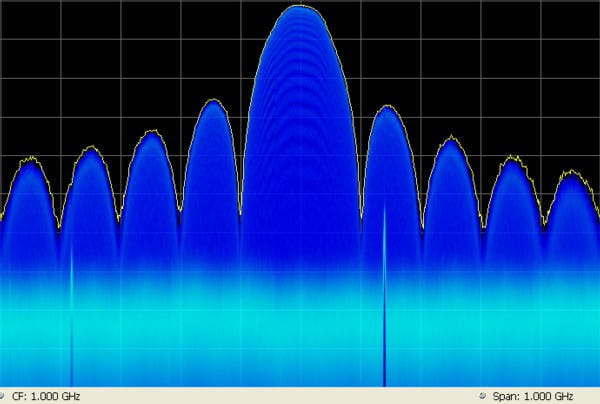
與我們聯絡
與 Tek 業務代表即時對談。 上班時間:上午 6:00 - 下午 4:30 (太平洋時間)
請致電
與 Tek 業務代表即時對談。 上班時間:上午 8:30 - 下午 5:30 (太平洋時間)
下載
下載手冊、產品規格表、軟體等等:
意見回饋
Spectrum Analzyers Datasheet
SPECMON Series
Tektronix 不再銷售此產品規格表上的產品。
檢視 Tektronix Encore 以取得檢修測試設備。
檢查這些產品的支援和保固狀態。
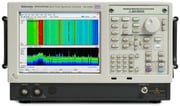
Discover, capture and analyze elusive events in the field faster than ever before with the SPECMON Spectrum Analyzer. With the patented swept DPX technology, advanced triggering, and wide capture bandwidth, SPECMON can discover and capture events as short as 0.434 µs with 100% probability of intercept, helping you to find interferers fast.
Key features
- Leading real time technologies help to troubleshoot the toughest transient interferences in the field
- Unique Swept DPX™ enables the customer to "Real-Time Scan" the whole 3/6.2/26.5 GHz frequency range for transient interference discovery
- Up to 165 MHz ultra-wide real-time BW SFDR of 80 dBc over the entire acquisition bandwidth for "close-in" signal discovery, capture and real-time demodulation
- Exceptional DPX Density Trigger/Trigger on This™, Frequency Mask Trigger and other advanced triggering capabilities provide 100% probability of intercept for signals as short as 0.434 μs in the frequency domain and 12 ns in the time domain
- Save hours of post-capture review time with optional advanced triggering capabilities such as Save-on-Trigger, which intelligently saves events of interest automatically
- Integrated solution design reduces total cost of ownership with lower initial purchase cost and annual maintenance cost
- Both manual and automatic drive test are supported by built-in mapping software, plus signal strength function provides audio tone and visual indication of received signal strength. Commercial off-the-shelf 3rd party GPS receiver supported via USB or Bluetooth® connection
- Field pulse analysis (for example, airport radar) is easier than ever with automated Pulse Analysis suite
- Save up to 12 years of gap-free DPX Spectrogram/Real-Time Waterfall Traces (Opt. 53) or up to 5.37 seconds of IQ data at full 165 MHz BW (Opt. B16x) with extra-large real-time memory, eliminating the need for an external data recorder in many cases
- Full 165 MHz bandwidth real-time IQ data can be streamed to external, data recording devices (Opt. 65) for comprehensive post analysis
- Instrumentation needs for frequency-domain, modulation-domain and time-domain analysis are simplified by native 3-in-1 multiple-domain correlation and analysis capability
- Modulation analysis for 20+ general purpose analog and digital signal types, including AM/FM demodulation, LTE™ Base Station, APCO P25 transmitter and flexible WLAN or Bluetooth signal analysis
- Built-in versatile field measurement items including Field Strength, Signal Strength, EMI test, Channel Power, ACPR, OBW, and Spurious Search
- Ruggedness and data security achieved with standard field-removable solid-state drive
- Open data format improves asset utilization through compatibility with industry-standard products
- Captured IQ data can be saved into Matlab, CSV or other formats for use with third-party software analysis tools
- RSA MAP supports MapInfo format and scanned version maps, also supports exporting to popular Google Earth and MapInfo map format for post analysis
- Open interface for integration into customer applications
- Ease-of-use platform improves field-test efficiency and lowers system training cost
- Windows 7 Ultimate (64-bit) with support to Microsoft language localization
Integrated real-time solutions

Advanced Triggers and Swept DPX re-invents the way swept spectrum analysis is done. The DPX engine collects hundreds of thousands of spectrums per second over a 165 MHz bandwidth. Users can sweep the DPX across the full input range of the SPECMONB Series, up to 26.5 GHz. In the time a traditional spectrum analyzer has captured one spectrum, the SPECMONB Series has captured orders of magnitude more spectrums. This new level of performance reduces the chance of missing time-interleaved and transient signals during broadband searches.
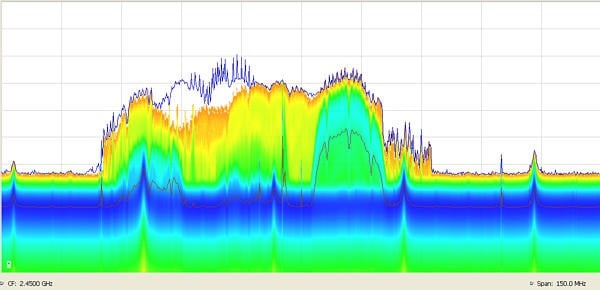
Advanced Triggers, Swept DPX, and Zero Span provides superior swept spectrum analysis for transient signals. Here, a 150 MHz swath of spectrum is swept across the ISM band. Multiple WLAN signals are seen, and narrow signals seen in the blue peak-hold trace are Bluetooth access probes. Multiple interfering signals are seen below the analyzers noise level in the multi-color DPX display.
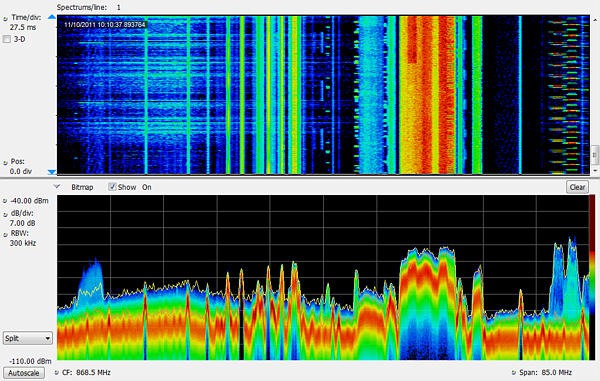
DPX Spectrograms provide gap-free spectral monitoring for up to 12 years at a time. 60,000 traces can be recorded and reviewed, with resolution per line adjustable from 125 µs to 6400 s.
Discover
The patented DPX®spectrum processing engine brings live analysis of transient events to spectrum analyzers. Performing up to 3,125,000 frequency transforms per second, transients of a minimum event duration of 0.434 μs in length are displayed in the frequency domain. This is orders of magnitude faster than swept analysis techniques. Events can be color coded by rate of occurrence onto a bitmapped display, providing unparalleled insight into transient signal behavior. The DPX spectrum processor can be swept over the entire frequency range of the instrument, enabling broadband transient capture previously unavailable in any spectrum analyzer. In applications that require only spectral information, DPX spectograms provides gap-free spectral recording, replay, and analysis of up to 60,000 spectral traces. Spectrum recording resolution is variable from 125 µs to 6400 s per line.
Trigger
Tektronix has a long history of innovative triggering capability, and the SPECMONB Series spectrum analyzers lead the industry in triggered signal analysis. The SPECMONB Series provides unique triggers essential for troubleshooting modern digitally implemented RF systems. Includes time-qualified power, runt, density, frequency, and frequency mask triggers.
Time qualification can be applied to any internal trigger source, enabling capture of 'the short pulse' or 'the long pulse' in a pulse train, or, when applied to the frequency mask trigger, only triggering when a frequency domain event lasts for a specified time. Runt triggers capture troublesome infrequent pulses that either turn on or turn off to an incorrect level, greatly reducing time to fault.
DPX Density™ trigger works on the measured frequency of occurrence or density of the DPX display. The unique Trigger On This™ function allows the user to simply point at the signal of interest on the DPX display, and a trigger level is automatically set to trigger slightly below the measured density level. You can capture low-level signals in the presence of high-level signals at the click of a button.
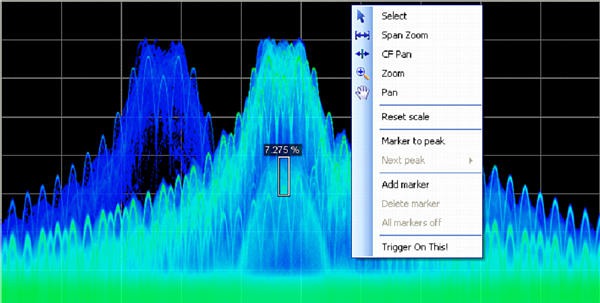
Revolutionary DPX ® spectrum display reveals transient signal behavior that helps you discover instability, glitches, and interference. Here, three distinct signals can be seen. Two high-level signals of different frequency-of-occurrence are seen in light and dark blue, and a third signal beneath the center signal can also be discerned. The DPX Density™ trigger allows the user to acquire signals for analysis only when this third signal is present. Trigger On This™ has been activated, and a density measurement box is automatically opened, measuring a signal density 7.275%. Any signal density greater than the measured value will cause a trigger event.
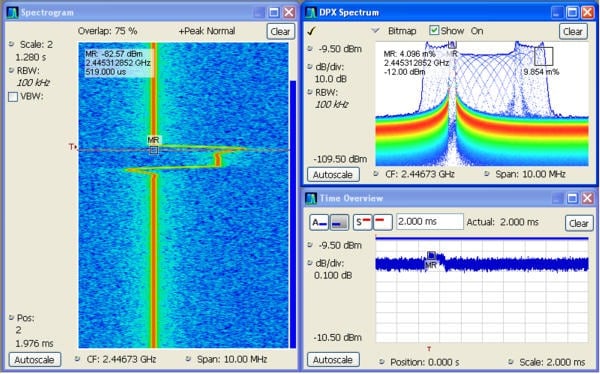
Trigger and Capture: The DPX Density™ Trigger monitors for changes in the frequency domain, and captures any violations into memory. The spectrogram display (left panel) shows frequency and amplitude changing over time. By selecting the point in time in the spectrogram where the spectrum violation triggered the DPX Density™ Trigger, the frequency domain view (right panel) automatically updates to show the detailed spectrum view at that precise moment in time.
The Frequency mask trigger (FMT) is easily configured to monitor all changes in frequency occupancy within the acquisition bandwidth.
A Power Trigger working in the time domain can be armed to monitor for a user-set power threshold. Resolution bandwidths may be used with the power trigger for band limiting and noise reduction. Two external triggers are available for synchronization to test system events.
Capture
Real-time capture of small signals in the presence of large signals is enabled with greater than 70 dB SFDR in all acquisition bandwidths, even up to 165 MHz (Opt. B16x). The dynamic range of the wideband acquisition system can be improved to an unmatched 80 dB with the options B85HD, B125HD, and B16xHD. Capture once - make multiple measurements without recapturing. All signals in an acquisition bandwidth are recorded into the SPECMONB Series deep memory. Record lengths vary depending upon the selected acquisition bandwidth - up to 5.37 seconds at 165 MHz. Acquisitions of up to 2 GB can stored in MATLAB™ Level 5 format for offline analysis.
Most spectrum analyzers use narrowband tunable band pass filters, often YIG tuned filters (YTF) to serve as a preselector. These filters provide image rejection and improve spurious performance in swept applications by limiting the number of signals present at the first mixing stage. YTF's are narrow band devices by nature and are usually limited to bandwidths less than 50 MHz. These analyzers bypass the input filter when performing wideband analysis, leaving them susceptible to image responses when operating in modes where wideband analysis is required such as for real time signal analysis.
Unlike spectrum analyzers with YTF's, Tektronix Real Time Signal Analyzers use a wideband image-free architecture guaranteeing that signals at frequencies outside of the band to which the instrument is tuned don't create spurious or image responses. This image-free response is achieved with a series of input filters designed such that all image responses are suppressed. The input filters are overlapped by greater than the widest acquisition bandwidth, ensuring that full-bandwidth acquisitions are always available. This series of filters serves the purpose of the preselector used by other spectrum analyzers, but has the benefit of always being on while still providing the image-free response in all instrument bandwidth settings and at all frequencies.
Analyze
The SPECMONB Series offers analysis capabilities that advance productivity for engineers working on components or in RF system design, integration, and performance verification, or operations engineers working in networks, or spectrum management. In addition to spectrum analysis, spectrograms display both frequency and amplitude changes over time. Time-correlated measurements can be made across the frequency, phase, amplitude, and modulation domains. This is ideal for signal analysis that includes frequency hopping, pulse characteristics, modulation switching, settling time, bandwidth changes, and intermittent signals.
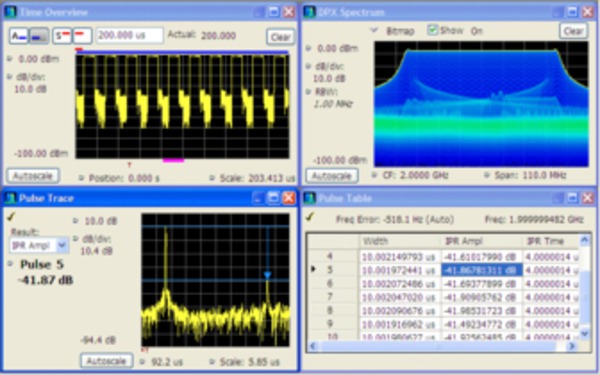
Advanced signal analysis package offers over 30 automated pulse parameter calculations on every pulse. Easily validate designs with measurements of peak power, pulse width rise time, ripple, droop, overshoot, and pulse-to-pulse phase. Gain insight into linear FM chirp quality with measurements such as Impulse Response and Phase Error. A pulse train (upper left) is seen with automatic calculation of pulse width and impulse response (lower right). A detailed view of the Impulse Response is seen in the lower left, and a DPX ® display monitors the spectrum on the upper right.
The measurement capabilities of the SPECMONB Series and available options and software packages are summarized next.
Measurement functions
| Standard Measurements | Description |
|---|---|
| Spectrum analyzer measurements | Channel power, Adjacent channel power, Multicarrier adjacent channel power/leakage ratio, Spectrum emissions mask, Occupied bandwidth, xdB down, dBm/Hz marker, dBc/Hz marker |
| Real time measurements | DPX Spectrum with density measurements, DPX spectrogram with spectrums vs. time, zero-span DPX with up to 50,000 updates/sec |
| Time domain and statistical measurements | RF IQ vs Time, Power vs Time, Frequency vs Time, Phase vs Time, CCDF, Peak-to-Average Ratio |
| Spur search measurement | Up to 20 frequency ranges, user-selected detectors (Peak, Average, QP), filters (RBW, CISPR, MIL), and VBW in each range. Linear or log frequency scale. Measurements and violations in absolute power or relative to a carrier. Up to 999 violations identified in tabular form for export in .CSV format |
| Analog modulation analysis measurement functions | % amplitude modulation (+, -, total) frequency modulation (±Peak, +Peak, -Peak, RMS, Peak-Peak/2, frequency error) phase modulation (±Peak, RMS, +Peak, -Peak) |
| Advanced pulse measurements suite | Pulse-Ogram™ waterfall display of multiple segmented captures, with amplitude vs time and spectrum of each pulse. Pulse frequency, Delta Frequency, Average on power, Peak power, Average transmitted power, Pulse width, Rise time, Fall time, Repetition interval (seconds), Repetition interval (Hz), Duty factor (%), Duty factor (ratio), Ripple (dB), Ripple (%), Droop (dB), Droop (%), Overshoot (dB), Overshoot (%), Pulse- Ref Pulse frequency difference, Pulse- Ref Pulse phase difference, Pulse- Pulse frequency difference, Pulse- Pulse phase difference, RMS frequency error, Max frequency error, RMS phase error, Max phase error, Frequency deviation, Phase deviation, Impulse response (dB), Impulse response (time), Time stamp. |
| Mapping and Signal Strength | Both manual and automatic drive test are supported by built-in mapping software. Commercial off-the-shelf third party GPS receiver supported via USB or Bluetooth connection. Supports MapInfo format and scanned version maps, also supports exporting to popular Google Earth and MapInfo map format for post analysis. Signal strength measurement provides both a visual indicator and audible tone of signal strength. |
| DPX density measurement | Measures % signal density at any location on the DPX spectrum display and triggers on specified signal density |
| Measurement options | Description |
|---|---|
| AM/FM/PM modulation and audio measurements (Opt. 10) | carrier power, frequency error, modulation frequency, modulation parameters (±Peak, Peak-Peak/2, RMS), SINAD, modulation distortion, S/N, THD, TNHD |
| Phase noise and jitter measurements (Opt. 11) | 10 Hz to 1 GHz frequency offset range, log frequency scale traces - 2: ±Peak trace, average trace, trace smoothing, and averaging |
| Settling Time (Frequency and Phase) (Opt. 12) | Measured frequency, Settling time from last settled frequency, Settling time from last settled phase, Settling time from trigger. Automatic or manual reference frequency selection. User-adjustable measurement bandwidth, averaging, and smoothing. Pass/Fail mask testing with 3 user-settable zones |
| General Purpose Digital Modulation Analysis (Opt. 21) | Error vector magnitude (EVM) (RMS, Peak, EVM vs time), Modulation error ratio (MER), Magnitude error (RMS, Peak, Mag error vs time), Phase error (RMS, Peak, Phase error vs time), Origin offset, Frequency error, Gain imbalance, Quadrature error, Rho, Constellation, Symbol table |
| Flexible OFDM Analysis (Opt. 22) | OFDM analysis for WLAN 802.11a/j/g and WiMAX 802.16-2004 |
| WLAN 802.11a/b/g/j/p measurement application (Opt. 23) | All of the RF transmitter measurements as defined in the IEEE standard, as well as a wide range of additional measurements including Carrier Frequency error, Symbol Timing error, Average/peak burst power, IQ Origin Offset, RMS/Peak EVM, and analysis displays, such as EVM and Phase/Magnitude Error vs. time/frequency or vs. symbols/ subcarriers, as well as packet header decoded information and symbol table. Option 24 requires option 23. Option 25 requires option 24. |
| WLAN 802.11n measurement application (Opt. 24) | |
| WLAN 802.11ac measurement application (Opt. 25) | |
| APCO P25 compliance testing and analysis application (Opt. 26) | Complete set of push-button TIA-102 standard-based transmitter measurements with pass/fail results including ACPR, transmitter power and encoder attack times, transmitter throughput delay, frequency deviation, modulation fidelity, symbol rate accuracy, and transient frequency behavior, as well as HCPM transmitter logical channel peak ACPR, off slot power, power envelope, and time alignment. |
| Bluetooth Basic LE TX SIG measurements (Opt. 27) | Presets for transmitter measurements defined by Bluetooth SIG for Basic Rate and Bluetooth Low Energy. Results also include Pass/Fail information. Application also provides packet header field decoding and can automatically detect the standard, including Enhanced Data Rate. |
| Noise Figure and Gain Measurements (Opt. 14) | Measurement displays of noise figure, gain, Y-factor, noise temperature, plus tabular results. Single-frequency metering and swept-trace results are available. Support for industry-standard noise sources. Measures amplifiers and other non-frequency converting devices plus fixed local-oscillator up and down converters. Performs mask testing to user-defined limits. Built in uncertainty calculator. |
| LTE Downlink RF measurements (Opt. 28) | Presets for Cell ID, ACLR, SEM, Channel Power and TDD Toff Power. Supports TDD and FDD frame format and all base stations defined by 3GPP TS version 12.5. Results include Pass/Fail information. Real-Time settings make the ACLR and the SEM measurements fast, if the connected instrument has required bandwidth. |
| Signal Classification | The signal classification application enables expert systems guidance to aid the user in classifying signals. It provides graphical tools that allow you to quickly create a spectral region of interest, enabling you to classify and sort signals efficiently. |
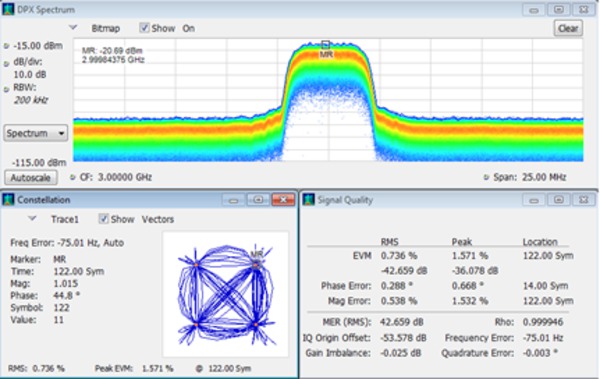
Multiple domain views provide a new level of insight into design problems not possible with conventional analyzers, here, modulation quality and constellation view are combined with the continuous monitoring of the DPX spectrum display.
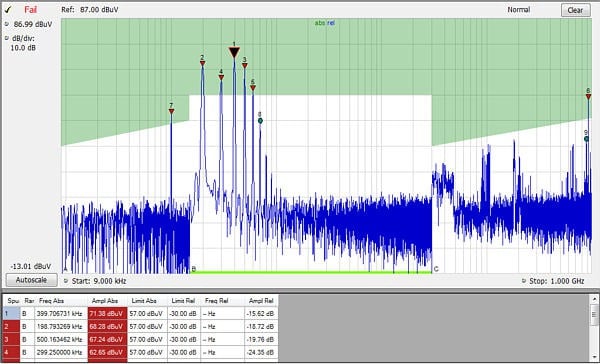
Spurious Search - Up to 20 noncontiguous frequency regions can be defined, each with their own resolution bandwidth, video bandwidth, detector (peak, average, quasi-peak), and limit ranges. Test results can be exported in .CSV format to external programs, with up to 999 violations reported. Spectrum results are available in linear or log scale.
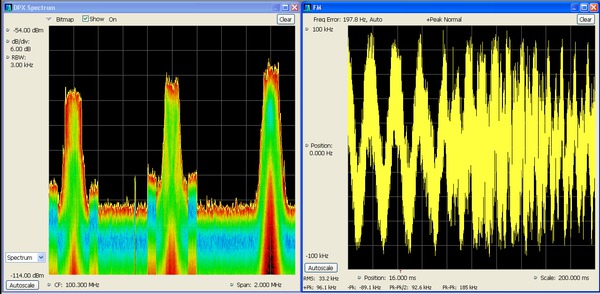
Audio monitoring and modulation measurements simultaneously can make spectrum management an easier, faster task. Here, the DPX spectrum display shows a live spectrum of the signal of interest and simultaneously provides demodulated audio to the internal instrument loudspeaker. FM deviation measurements are seen in the right side of the display for the same signal .
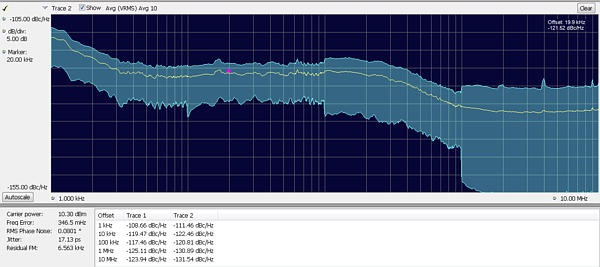
Phase noise and jitter measurements (Opt. 11) on the SPECMONB Series may reduce the cost of your measurements by reducing the need for a dedicated phase noise tester. Outstanding phase noise across the operating range provides margin for many applications. Here, phase noise on a 13 MHz carrier is measured at -119 dBc/Hz at 10 kHz offset. The instrument phase noise of < -134 dBc/Hz at this frequency provides ample measurement margin for the task.
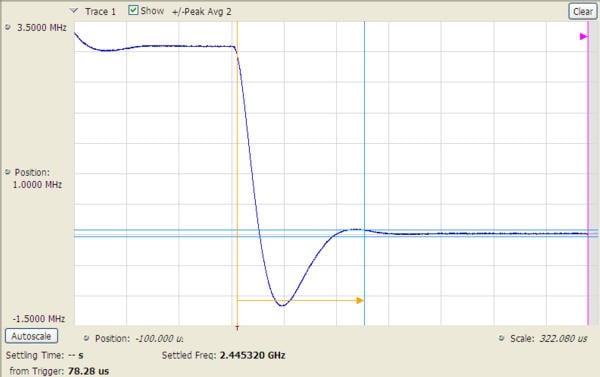
Settling time measurements (Opt. 12) are easy and automated. The user can select measurement bandwidth, tolerance bands, reference frequency (auto or manual), and establish up to 3 tolerance bands vs. time for Pass/Fail testing. Settling time may be referenced to external or internal trigger, and from the last settled frequency or phase. In the illustration, frequency settling time for a hopped oscillator is measured from an external trigger point from the device under test.
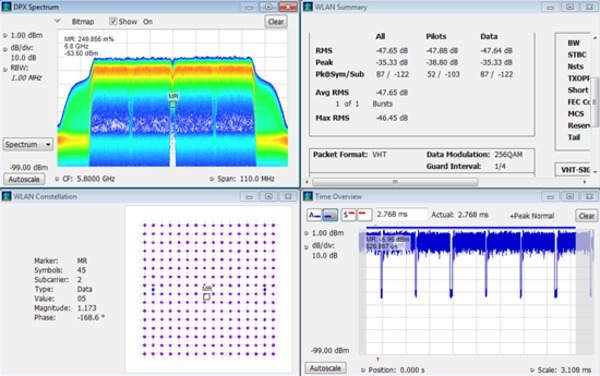
Analysis options for 802.11 standards are available. Here, an 802.11ac 160 MHz bandwidth signal is analyzed, with displays of constellation, amplitude vs. time, summary of WLAN measurements, and the DPX spectrum of the analyzed signal. The density of the 'shoulders' of the WLAN signal are clearly seen in the DPX display, and a marker has been placed on the suppressed center carrier of the signal. An EVM of -47.65 dB and other signal measurements are seen in the summary panel
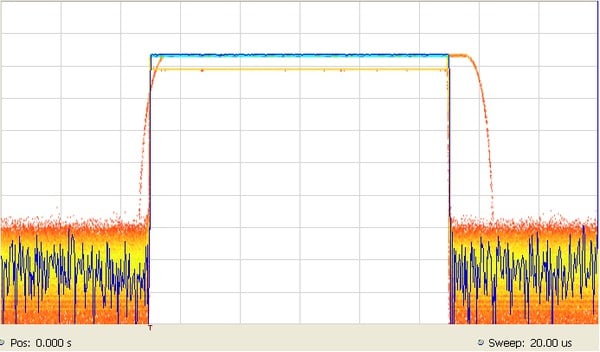
DPX Zero-span produces real-time analysis in amplitude, frequency, or phase vs. time. Up to 50,000 waveforms per second are processed. DPX Zero-span ensures that all time-domain anomalies are immediately found, reducing time-to-fault. Here, three distinct pulse shapes are captured in zero-span amplitude vs. time. Two of the three waveforms occur only once in 10,000 pulses, but all are displayed with DPX.
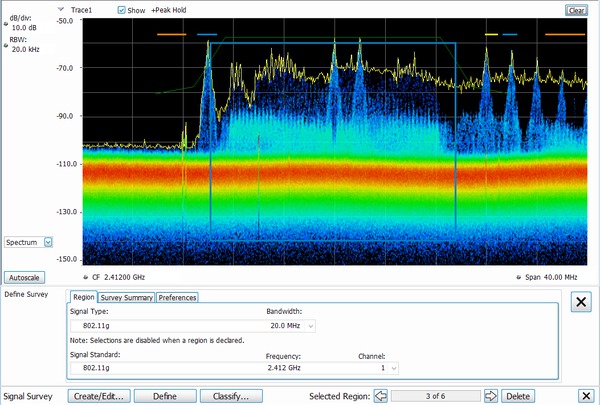
In this illustration, a single region has been selected. Since we have declared this to be an 802.11g signal, the spectrum mask for the 802.11g signal is shown overlaid in the region. The signal is a close match to the spectrum mask; However we can see some interferences with some likely Bluetooth signals in the ISM band
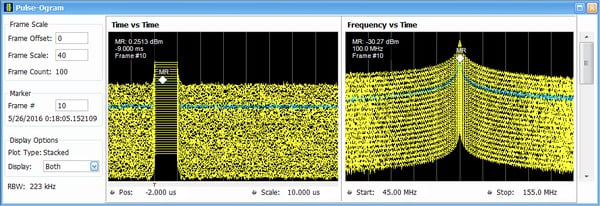
Pulse-Ogram displays a waterfall of multiple segmented captures, with correlated amplitude vs time and spectrum of each pulse. Can be used with an external trigger to show target range and speed.
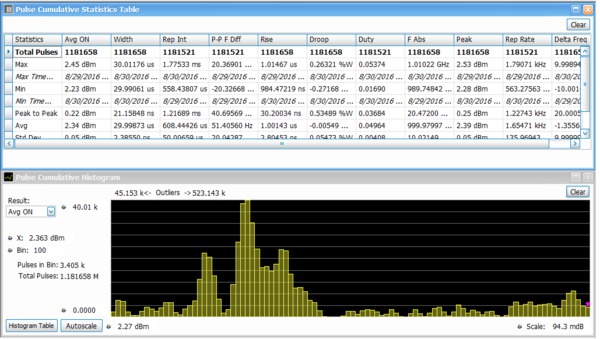
Cumulative statistics provides timestamps for Min, Max values as well as Peak to Peak, Average and Standard deviation over multiple acquisitions, further extending the analysis. Histogram shows you outliers on the right and left.

Noise Figure and Gain measurements (Option 14) help you to quickly and easily measure your device using the RTSA and a noise source. This image shows the measurement summary table with graphs of noise temperature, gain, noise figure and Y-factor.
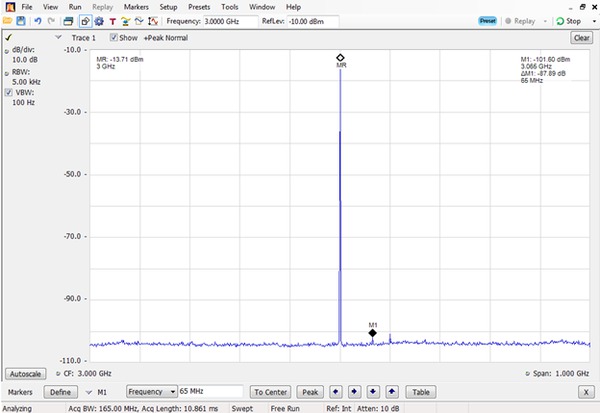
The wide-bandwidth, high dynamic range options (B85HD, B125HD, and B16xHD) offer unmatched real time spectrum analysis dynamic range. Two 16-bit, 200 MS/sec digitizers are interleaved, resulting in 400 MS/sec acquisitions with a typical spurious free dynamic range of -80 dBc, up to 10 dB better than other commercially available instruments. Here, a signal at 3 GHz is measured at -13.71 dBm, with the largest spurious signal from the digitizer -87.89 dB below the carrier.
Integrated solution for mapping
SPECMONB Series Real-Time Spectrum Analyzers provide an integrated solution for field interference and coverage problems. The built-in RSA Map lets you use an on-screen map to record the location and value of SPECMONB measurements.
With RSA Map you can do the following:
- Select a measurement and touch the displayed map where you want the measurement to be placed
- Use a GPS receiver (customer supplied) to automatically position measurements at your current location (on maps with geophysical reference information)
- Collect and export measurement data (and position data when using a GPS receiver) to common formats to help analyze measurements (position, value, and direction) and prepare reports to resolve interference problems
RSA Map uses MapInfo format map files (.mif) or Windows bitmap files (.bmp) to indicate location. The .bmp format map files can be either geo-referenced or non-geo-referenced. Saved test results give you complete measurement data along with exporting compatibility to Google Earth (.kmz) and Mapinfo (MIF/MID) formats.
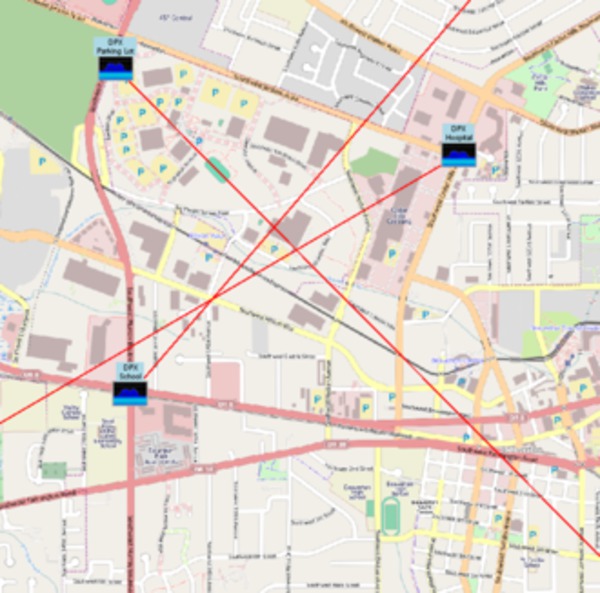
Locate interference with azimuth direction function. It lets you draw a line or an arrow on a mapped measurement to indicate the direction your antenna was pointing when you take a measurement. User label can also be displayed (this example shows real time DPX measurement taken from Hospital, School and Park Lot)

Both manual and automatic drive test measurements are supported. The Repeat measurements function automatically takes measurements at a user-set time or distance interval.
Specifications
| SPECMON3B | SPECMON6B | SPECMON26B | |
|---|---|---|---|
| Frequency range | 1 Hz to 3.0 GHz | 1 Hz to 6.2 GHz | 1 Hz to 26.5 GHz |
| Real-time acquisition BW | 25 MHz (SPECMON3B only), 40 MHz, 85 MHz, 125 MHz, 165 MHz | ||
| Minimum Event Duration for 100% POI at 100% amplitude | 2.7 μs at 165 MHz BW (0.434 μs Opt. 300) 2.8 μs at 85 MHz BW (0.551 μs Opt. 300) 3.0 μs at 40 MHz BW (0.79 μs Opt. 300) 3.2 μs at 25 MHz BW (0.915 μs Opt. 300) | ||
| SFDR (typical) | >75 dBc (25/40 MHz) >73 dBc (85/125/165 MHz) ≥80 dBc (Opt. B85HD, B125HD, B16xHD) | ||
| Trigger modes | Free run, Triggered, FastFrame | ||
| Trigger types | Power, Frequency mask, Frequency edge, DPX density, Runt, Time qualified | ||
Frequency related
- Initial center frequency setting accuracy
- Within 10–7 after 10 minute warm-up
- Center frequency setting resolution
- 0.1 Hz
- Frequency marker readout accuracy
±(RE × MF + 0.001 × Span + 2) Hz
(RE = Reference frequency error)
(MF = Marker frequency (Hz))
- Span accuracy
- ±0.3% (auto mode)
- Reference frequency
- Initial accuracy at cal
- ± 1 × 10–7 (after 10 minute warm-up)
- Aging per day
- 1 × 10–9 (after 30 days of operation)
- First year aging (typical)
- 7.5 × 10–8 (after 1 year of operation)
- Aging per 10 years
- 3 × 10–7 (after 10 years of operation)
- Temperature drift
- 1 × 10–7 (5° C to 40° C)
- Cumulative error (temperature + aging)
- 4 × 10–7 (within 10 years after calibration, typical)
- Reference output level
- >0 dBm (internal or external reference selected), +4 dBm, typical
- External reference input frequency
Every 1 MHz from 1 to 100 MHz plus 1.2288 MHz, 4.8 MHz, and 19.6608 MHz.
External input must be within ± 1 x 10 -6(Std), ± 3 x 10 -7(Opt PFR) to stated input
- External reference input frequency requirements
- Spurious level on input must be < –80 dBc within 100 kHz offset to avoid on-screen spurs
- Spurious
- < –80 dBc within 100 kHz offset
- Input level range
- –10 dBm to +6 dBm
Trigger related
- Trigger modes
- Free run, triggered, FastFrame
- Trigger event source
- RF input, Trigger 1 (front panel), Trigger 2 (rear panel), Gated, Line
- Trigger types
- Power, Frequency Mask, Frequency Edge, DPX Density, Runt, Time Qualified
- Trigger setting
- Trigger position settable from 1 to 99% of total acquisition length
- Trigger combinatorial logic
- Trigger 1 AND trigger 2 / gate may be defined as a trigger event
- Trigger actions
- Save acquisition and/or save picture on trigger
Power level trigger
- Level range
- 0 dB to –100 dB from reference level
- Accuracy
- For trigger levels >30 dB above noise floor, 10% to 90% of signal level
- Level ≥ –50 dB from reference level
- ±0.5 dB
- From < –50 dB to –70 dB from reference level
- ±1.5 dB
- Trigger bandwidth range
- At maximum acquisition bandwidth
- Standard
- 4 kHz to 10 MHz + wide open
- Opt. B40
- 4 kHz to 20 MHz + wide open
- Opt. B16x
- 11 kHz to 40 MHz + wide open
- Trigger position timing uncertainty
- 25/40 MHz acquisition BW, 20 MHz Trigger BW
- Uncertainty = ±15 ns
- 25/40 MHz acquisition BW, Max Trigger BW
- Uncertainty = ±12 ns
- 85/125/165 MHz acquisition BW, 60 MHz Trigger BW
- Uncertainty = ±5 ns
- 85/125/165 MHz acquisition BW, Max Trigger BW
- Uncertainty = ±5 ns
- Trigger re-arm time, minimum (fast frame on)
- 10 MHz acquisition BW
- ≤25 μs
- 40 MHz acquisition BW
- ≤10 μs
- 85/125 MHz acquisition BW
- ≤5 μs
- 165 MHz acquisition BW
- ≤5 μs
- Minimum event duration
- 25 MHz acquisition BW
- 25 ns
- 40 MHz acquisition BW
- 25 ns
- 85/125/165 MHz acquisition BW
- 6.2 ns
External trigger 1
- Level range
- -2.5 V to +2.5 V
- Level setting resolution
- 0.01 V
- Trigger position timing uncertainty
- 50 Ω input impedance
- >20 MHz to 40 MHz acquisition BW:
- ±20 ns
- >40 MHz to 80 MHz acquisition BW:
- ±13.5 ns
- >80 MHz to 165 MHz acquisition BW:
- ±11 ns
- Input impedance
- Selectable 50 Ω/5 kΩ impedance (nominal)
External trigger 2
- Threshold voltage
- Fixed, TTL
- Input impedance
- 10 kΩ (nominal)
- Trigger state select
- High, Low
Trigger output
- Voltage
- Output current <1 mA
- High
- >2.0 V
- Low
- <0.4 V
Acquisition related
- A/D converter
- 16 bits, 200 MS/s (Std & Opt B40); 16 bits, 200 MS/s & 14 bits, 400 MS/s (Opt. B85/B125/B16x); 16 bits, 200 MS/s & 16 bits, 400 MS/s, 16 bit (Opt. B85HD,B125HD, B16xHD)
- Acquisition memory size
- 1 GB (4 GB, opt. 53)
- Minimum acquisition length
- 64 samples
- Acquisition length setting resolution
- 1 sample
- Fast frame acquisition mode1
- >Up to 1 million records can be stored in a single acquisition (for pulse measurements and spectrogram analysis with option 53)
1Exact number depends on Bandwidth, Sample Rate, Acquisition time. Achieved up to 200,000 pulses
- Memory depth (time) and minimum time domain resolution
Acquisition BW Sample rate (for I and Q)
Record length Record length (Opt. 53)
Time resolution 165 MHz 200 MS/s 1.34 s 5.37 s 5 ns 85 MHz 200 MS/s 1.34 s 5.37 s 5 ns 80 MHz 100 MS/s 2.68 s 10.74 s 10 ns 40 MHz 50 MS/s 4.77 s 19.09 s 20 ns 25 MHz 50 MS/s 4.77 s 19.09 s 20 ns 20 MHz 25 MS/s 9.54 s 38.18 s 40 ns 10 MHz 12.5 MS/s 19.09 s 76.35 s 80 ns 5 MHz 6.25 MS/s 38.18 s 152.71 s 160 ns 2 MHz 3.125 MS/s 42.9 s 171.8 s 320 ns 1 MHz 1.563 MS/s 85.9 s 343.6 s 640 ns 500 kHz 781.25 kS/s 171.8 s 687.2 s 1.28 μs 200 kHz 390.625 kS/s 343.6 s 1374.4 s 2.56 μs 100 kHz 195.313 kS/s 687.2 s 2748.8 s 5.12 μs 50 kHz 97.656 kS/s 1374.4 s 5497.6 s 10.24 μs 20 kHz 48.828 kS/s 2748.8 s 10995.1 s 20.48 μs 10 kHz 24.414 kS/s 5497.6 s 21990.2 s 40.96 μs 5 kHz 12.207 kS/s 10995.1 s 43980.5 s 81.92 μs 2 kHz 3.052 kS/s 43980.4 s 175921.8 s 328 μs 1 kHz 1.526 kS/s 87960.8 s 351843.6 s 655 μs 500 Hz 762.9 S/s 175921.7 s 703687.3 s 1.31 ms 200 Hz 381.5 S/s 351843.4 s 1407374.5 s 2.62 ms 100 Hz 190.7 S/s 703686.8 s 2814749.1 s 5.24 ms
Displays and measurements
- Frequency views
Spectrum (amplitude vs linear or log frequency)
DPX®spectrum display (live RF color-graded spectrum)
Spectrogram (amplitude vs frequency over time)
Spurious (amplitude vs linear or log frequency)
Phase noise (phase noise and Jitter measurement) (Opt. 11)
- Time and statistics views
Amplitude vs time
Frequency vs time
Phase vs time
DPX amplitude vs time
DPX frequency vs time
DPX phase vs time
Amplitude modulation vs time
Frequency modulation vs time
RF IQ vs time
Time overview
CCDF
Peak-to-Average ratio
- Settling time, frequency, and phase (Opt. 12) views
- Frequency settling vs time, Phase settling vs time
- Noise figure and gain (Opt. 14) views
Noise figure vs. frequency
Gain vs. frequency
Noise figure, gain at a single frequency
Y-factor vs. frequency
Noise temperature vs. frequency
Uncertainty calculator
Results table of all measurements
- Advanced Pulse Analysis
Pulse results table
Pulse trace (selectable by pulse number)
Pulse statistics (trend of pulse results, FFT of time trend and histogram)
Cumulative Statistics, Cumulative Histogram and Pulse-Ogram
- Digital demod (Opt. 21) views
Constellation diagram
EVM vs time
Symbol table (binary or hexadecimal)
Magnitude and phase error versus time, and signal quality
Demodulated IQ vs time
Eye diagram
Trellis diagram
Frequency deviation vs time
- Flexible OFDM analysis (Opt. 22) views
Constellation, scalar measurement summary
EVM or power vs carrier
Symbol table (binary or hexadecimal)
- Frequency offset analysis
- Signal analysis can be performed either at center frequency or the assigned measurement frequency up to the limits of the instrument's acquisition and measurement bandwidths.
- WLAN 802.11a/b/g/j/p measurement application (Opt. 23)
WLAN Power vs time, WLAN symbol table, WLAN constellation, Spectrum emission mask
Error vector magnitude (EVM) vs symbol (or time), vs subcarrier (or frequency)
Mag error vs symbol (or time), vs subcarrier (or frequency)
Phase error vs symbol (or time), vs subcarrier (or frequency)
Channel frequency response vs symbol (or time), vs subcarrier (or frequency)
Spectral flatness vs symbol (or time), vs subcarrier (or frequency)
- WLAN 802.11n measurement application (Opt. 24)
WLAN Power vs time, WLAN symbol table, WLAN constellation, Spectrum emission mask
Error vector magnitude (EVM) vs symbol (or time), vs subcarrier (or frequency)
Mag error vs symbol (or time), vs subcarrier (or frequency)
Phase error vs symbol (or time), vs subcarrier (or frequency)
Channel frequency response vs symbol (or time), vs subcarrier (or frequency)
Spectral flatness vs symbol (or time), vs subcarrier (or frequency)
- WLAN 802.11ac measurement application (Opt. 25)
WLAN Power vs time, WLAN symbol table, WLAN constellation, Spectrum emission mask
Error vector magnitude (EVM) vs symbol (or time), vs subcarrier (or frequency)
Mag error vs symbol (or time), vs subcarrier (or frequency)
Phase error vs symbol (or time), vs subcarrier (or frequency)
Channel frequency response vs symbol (or time), vs subcarrier (or frequency)
Spectral flatness vs symbol (or time), vs subcarrier (or frequency)
- APCO P25 measurement application (Opt. 26)
RF output power, operating frequency accuracy, modulation emission spectrum,
unwanted emissions spurious, adjacent channel power ratio, frequency deviation,
modulation fidelity, frequency error, eye diagram, symbol table, symbol rate accuracy,
transmitter power and encoder attack time, transmitter throughput delay, frequency deviation vs. time,
power vs. time, transient frequency behavior, HCPM transmitter logical channel peak adjacent channel power ratio,
HCPM transmitter logical channel off slot power, HCPM transmitter logical channel power envelope,
HCPM transmitter logical channel time alignment, cross-correlated markers
- Bluetooth Basic LE Tx Measurements (Opt. 27)
Peak power, average power, adjacent channel power or inband emission mask,
-20dB bandwidth, frequency error, modulation characteristics including ΔF1avg (11110000),
ΔF2avg (10101010), ΔF2 > 115 kHz, ΔF2/ΔF1 ratio, frequency deviation vs. time with packet
and octet level measurement information, carrier frequency f0, frequency offset (Preamble
and Payload), max frequency offset, frequency drift f1-f0, max drift rate fn-f0
and fn-fn-5, center frequency offset table and frequency drift table, color-coded
symbol table, packet header decoding information, eye diagram, constellation diagram,
editable limits.
- LTE Downlink RF measurements (Opt. 28)
- Adjacent Channel Leakage Ratio (ACLR), Spectrum Emission Mask (SEM), Channel Power, Occupied Bandwidth, Power vs. Time displaying Transmitter OFF power for TDD signals and LTE constellation diagram for PSS, SSS with Cell ID, Group ID, Sector ID and Frequency Error.
Bandwidth related
- Resolution bandwidth
- Resolution bandwidth range (spectrum analysis)
- 0.1 Hz to 5 MHz (10 MHz, Opt. B16x) (1, 2, 3, 5 sequence, Auto-coupled), or user selected (arbitrary)
- Resolution bandwidth shape
- Approximately Gaussian, shape factor 4.1:1 (60:3 dB) ±10%, typical
- Resolution bandwidth accuracy
- ±1% (Auto-coupled RBW mode)
- Alternative resolution bandwidth types
- Kaiser window (RBW, gaussian), –6 dB mil, CISPR, Blackman-Harris 4B window, Uniform (none) window, Flat-top (CW ampl.) window, Hanning window
- Video bandwidth
- Video bandwidth range
- 1 Hz to 10 MHz plus wide open
- RBW/VBW maximum
- 10,000:1
- RBW/VBW minimum
- 1:1 plus wide open
- Resolution
- 5% of entered value
- Accuracy (typical)
- ±10%
- Time domain bandwidth (amplitude vs time display)
- Time domain bandwidth range
- At least 1/10 to 1/10,000 of acquisition bandwidth, 1 Hz minimum
- Time domain BW shape
≤10 MHz, approximately Gaussian, shape factor 4.1:1 (60:3 dB), ±10% typical
20 MHz (60 MHz, Opt. B16x), shape factor <2.5:1 (60:3 dB) typical
- Time domain bandwidth accuracy
- 1 Hz to 20 MHz, and (>20 MHz to 60 MHz Opt. B16x), ±10%
- Minimum settable spectrum analysis RBW vs. span
Frequency span RBW >10 MHz 100 Hz >1.25 MHz to 10 MHz 10 Hz ≤1 MHz 1 Hz ≤100 kHz 0.1 Hz
- Spectrum display traces, detector, and functions
- Traces
- Three traces + 1 math waveform + 1 trace from spectrogram for spectrum display
- Detector
- Peak, –Peak, Average (VRMS), ±Peak, Sample, CISPR (Avg, Peak, Quasi-peak average (of logs))
- Trace functions
- Normal, Average, Max hold, Min hold, Average (of logs)
- Spectrum trace length
- 801, 2401, 4001, 8001, 10401, 16001, 32001, 64001 points
- Sweep speed (typical-mean; RBW = auto, RF/IF optimization: minimize sweep time)
1500 MHz/s (Std.)
2500 MHz/s (Opt. B40)
6000 MHz/s (Opt. B16x)
- Minimum FFT length vs. Trace length (independent of span and RBW)
Trace length (points) Minimum FFT length 801 1024 2401 4096 4001 8192 10401 16384
DPX Related
- DPX® digital phosphor spectrum processing
Characteristic Performance Spectrum processing rate (RBW = auto, trace length 801) 390,625 per second Spectrum processing rate (RBW = auto, trace length 801) (Option 300 with Option 09) 3,125,000 per second for Span/RBW ratio ≤ 333 390,625 per second for Span/RBW ratio > 333 DPX bitmap resolution 201 × 801 DPX bitmap color dynamic range 233 levels Marker information Amplitude, frequency, and signal density on the DPX display Minimum signal duration for 100% probability of detection (Max-hold on) See minimum signal duration for 100% probability of trigger at 100% amplitude table Span Range (Continuous processing) 100 Hz to 25 MHz
(40 MHz with Opt. B40)
(85 MHz with Opt. B85/B85HD)
(125 MHz with Opt. B125/B125HD)
(165 MHz with Opt. B16x/B16xHD)Span range (Swept) Up to instrument frequency range Dwell time per step 1 50 ms to 100 s Trace processing Color-graded bitmap, +Peak, –Peak, average Trace length 801, 2401, 4001, 10401 Resolution BW accuracy ±0.5%
1Minimum RBW, swept spans (Opt. 200) – 10 kHz
- Resolution BW Range vs. Acquisition Bandwidth (DPX®)
Acquisition bandwidth RBW (Min) RBW (Max) 165 MHz 25 kHz 20 MHz 85 MHz 12.9 kHz 10 MHz 40 MHz 6.06 kHz 10 MHz 25 MHz 3.79 kHz 3.8 MHz 20 MHz 3.04 kHz 3.04 MHz 10 MHz 1.52 kHz 1.52 MHz 5 MHz 758 Hz 760 kHz 2 MHz 303 Hz 304 kHz 1 MHz 152 Hz 152 kHz 500 kHz 75.8 Hz 76 kHz 200 kHz 30.3 Hz 30.4 kHz 100 kHz 15.2 Hz 15.2 kHz 50 kHz 7.58 Hz 7.6 kHz 20 kHz 3.03 Hz 3.04 kHz 10 kHz 1.52 Hz 1.52 kHz 5 kHz 758 Hz 760 Hz 2 kHz 0.303 Hz 304 Hz 1 kHz 0.152 Hz 152 Hz 500 Hz 0.1 Hz 76 Hz 200 Hz 0.1 Hz 30.4 Hz 100 Hz 0.1 Hz 15.2 Hz
Stability
- Residual FM
- <2 Hzp-p in 1 second (95% confidence, typical).
Phase related
- Phase noise sidebands
dBc/Hz at specified center frequency (CF)
CF = 10 MHz CF = 1 GHz CF = 2 GHz CF = 6 GHz CF = 10 GHz CF = 20 GHz Offset Typical Spec/Typical Typical Typical Typical Typical 1 kHz –128 –103/–107 –107 –104 –99 –95 10 kHz –134 –109/–113 –112 –108 –108 –106 100 kHz –134 –112/–117 –115 –114 –108 –106 1 MHz –135 –130/–139 –137 –135 –128 –125 6 MHz –140 –137/–146 –142 –147 –145 –140 10 MHz NA –137/–146 –142 –147 –147 –144
- Integrated phase (RMS), typical
Integrated from 1 kHz to 10 MHz.
Measurement frequency Integrated phase, radians 1 GHz 1.01 × 10–3 2 GHz 1.23 × 10–3 6 GHz 1.51 × 10–3 10 GHz 2.51 × 10–3 20 GHz 3.27 × 10–3 Typical phase noise performance as measured by Opt. 11.

Amplitude
Specifications excluding mismatch error
- Measurement range
- Displayed average noise level to maximum measurable input
- Input attenuator range
- 0 dB to 55 dB, 5 dB step
- Maximum safe input level
- Average continuous
- +30 dBm (RF ATT ≥10 dB, preamp off)
- Average continuous
- +20 dBm (RF ATT ≥10 dB, preamp on)
- Pulsed RF
- 50 W (RF ATT ≥30 dB, PW <10 μs, 1% duty cycle)
- Maximum measurable input level
- Average continuous
- +30 dBm (RF ATT: Auto)
- Pulsed RF
- 10 W (RF Input, RF ATT: Auto, PW <10 μs, 1% duty cycle repetitive pulses)
- Max DC voltage
- ±5 V
- Log display range
- 0.01 dBm/div to 20 dB/div
- Display divisions
- 10 divisions
- Display units
- dBm, dBmV, Watts, Volts, Amps, dBuW, dBuV, dBuA, dBW, dBV, dBV/m, and dBA/m
- Marker readout resolution, dB units
- 0.01 dB
- Marker readout resolution, Volts units
- Reference-level dependent, as small as 0.001 μV
- Reference level setting range
- 0.1 dB step, –170 dBm to +50 dBm (minimum ref. level –50 dBm at center frequency <80 MHz)
- Level linearity
- ±0.1 dB (0 to –70 dB from reference level)
Amplitude accuracy
- Absolute amplitude accuracy at calibration point
- ±0.31 dB (100 MHz, –10 dBm signal, 10 dB ATT, 18 °C to 28 °C)
- Input attenuator switching uncertainty
±0.3 dB (SPECMON3B/SPECMON6B)
±0.15 dB (SPECMON26B)
- Absolute amplitude accuracy at center frequency, 95% confidence1
- 10 MHz to 3 GHz
- ±0.3 dB
- 3 GHz to 6.2 GHz (SPECMON6B)
- ±0.5 dB
- 6.2 GHz to 15 GHz (SPECMON26B)
- ±0.75 dB
- 15 GHz to 26.5 GHz (SPECMON26B)
- ±0.9 dB
118 °C to 28 °C, Ref Level ≤ -15 dBm, Attenuator Auto-coupled, Signal Level -15 dBm to -50 dBm. 10 Hz ≤ RBW ≤ 1 MHz, after alignment performed.
- VSWR
Typical SPECMON3B / SPECMON6B 1 Frequency range Preamp OFF (95% confidence) Preamp ON (Typical) Preamp ON, 0 dB attenuation (Typical) >10 kHz to 10 MHz <1.6 -- -- >10 MHz to 2.0 GHz <1.1 <1.2 <1.5 >2 GHz to 3 GHz <1.25 <1.4 <1.6 >3 GHz to 5 GHz <1.25 <1.4 <1.4 >5 GHz to 5.5 GHz <1.3 <1.4 <1.4 >5.5 GHz to 6.2GHz <1.3 <1.4 <1.75 Typical SPECMON26B 1 Frequency range Preamp OFF (95% confidence) Preamp ON (Typical) Preamp ON, 0 dB attenuation (Typical) >10 kHz to 10 MHz <1.6 -- -- 10 MHz to 3.0 GHz <1.3 <1.4 <1.9 >3.0 GHz to 6.2 GHz <1.3 <1.5 <1.9 >6.2 GHz to 11 GHz <1.5 <1.8 <2.25 >11 GHz to 15 GHz <1.5 <1.8 <1.9 >15 GHz to 22 GHz <1.5 <1.8 <1.9 >22 GHz to 25 GHz <1.7 <2.0 <1.9 >25 GHz to 26.5 GHz <1.7 <2.0 <2.1
1Atten. = 10 dB, CF set within 200 MHz of VSWR frequency
Frequency response
- 18 °C to 28 °C, atten. = 10 dB, preamp off
- 10 MHz to 32 MHz (LF band)
- ±0.7 dB
- 10 MHz to 3 GHz
- ±0.35 dB
- >3 GHz to 6.2 GHz (SPECMON6B)
- ±0.5 dB
- >6.2 GHz to 26.5 GHz (SPECMON26B)
- ±1.2 dB
- 5 °C to 40 °C, all attenuator settings (typical, preamp off)
- 100 Hz to 32 MHz (LF band)
- ±0.8 dB
- 9 kHz to 3 GHz
- ±0.5 dB
- >3 GHz to 6.2 GHz (SPECMON6B)
- ±1.0 dB
- >6.2 GHz to 26.5 GHz (SPECMON6B)
- ±1.5 dB
- Preamp on (Attenuation = 10 dB)
- 10 MHz to 32 MHz (LF band)
- ±0.8 dB
- 1 MHz to 3 GHz
- ±0.8 dB
- >3 GHz to 6.2 GHz (SPECMON6B)
- ±1.3 dB
- >6.2 GHz to 15 GHz (SPECMON26B)
- ±1.5 dB
- >15 GHz to 26.5 GHz (SPECMON26B)
- ±2.0 dB
Noise and distortion
- 3rd order intermodulation distortion at 2.13 GHz 1
- SPECMON3B / SPECMON6B
- –84 dBc
- SPECMON26B
- –80 dBc
1Each signal level –25 dBm, Ref level –20 dBm, Attenuator = 0 dB, 1 MHz tone separation.
- 3rd order intermodulation distortion – typical 1
- Note: 3rd order intercept point is calculated from 3rd order intermodulation performance.
Frequency range 3rd order intermodulation distortion, dBc (typical) 3rd order intercept, dBm (typical) SPECMON3B/6B SPECMON26B SPECMON3B/6B SPECMON26B 10 kHz to 32 MHz (LF band) –75 –75 +12.5 +12.5 1 MHz to 120 MHz –70 –70 +10 +10 >80 MHz to 300 MHz –76 –76 +13 +13 >300 MHz to 6.2 GHz –84 –82 +17 +16 >6.2 GHz to 15 GHz -- –72 -- +11 15 GHz to 26.5 GHz -- –72 -- +11
1Each signal level –25 dBm, Ref level –20 dBm, Attenuator = 0 dB, 1 MHz tone separation.
- 3rd order intermodulation distortion (preamp ON) – typical 1
- Note: 3rd order intercept point is calculated from 3rd order intermodulation performance.
Frequency range 3rd order intermodulation distortion, dBc (typical) 3rd order intercept, dBm (typical) Specmon3/6/3B/6B Specmon26/26B Specmon3/6/3B/6B Specmon26/26B 1 MHz to 32 MHz (LF band) -75 -75 -12.5 -12.5 1 MHz to 120 MHz -70 -80 -15 -10 >120 MHz to 300 MHz -75 -80 -12.5 -10 >300 MHz to 3.0 GHz -80 -90 -10 -5 >3.0 GHz to 6.2 GHz -90 -90 -5 -5 >6.2 GHz to 15 GHz -- -80 -- -10 >15 GHz to 126.5 GHz -- -80 -- -10
1Each signal level –25 dBm, Ref level –20 dBm, Attenuator = 0 dB, 1 MHz tone separation.
- 2nd harmonic distortion 1
- –40 dBm at RF input, Attenuator = 0, Preamp off, typical.
Frequency range 2nd order harmonic distortion SPECMON3B/6B SPECMON26B 10 MHz to 1 GHz –80 –80 >1 GHz to 3.1 GHz –83 -- >500 MHz to 1 GHz -- –74 >1 GHz to 3.1 GHz -- –74 >3.1 GHz to 7.5 GHz -- –85 >7.5 GHz to 13.25 GHz -- –85
1–40 dBm at RF input, attenuator = 0, preamp off, typical
- Displayed average noise level, Preamp off 1
SPECMON3B / SPECMON6B Frequency range Spec, dBm/Hz Typical , dBm/Hz LF Band 1 Hz to 100 Hz -- –129 >100 Hz to 2 kHz –124 –143 >2 kHz to 10 kHz –141 –152 >10 kHz to 32 MHz –150 –153 RF band 9 kHz to 1 MHz –108 –111 >1 MHz to 10 MHz –136 –139 >10 MHz to 2 GHz –153 –157 >2 GHz to 3 GHz –152 –156 >3 GHz to 4 GHz (SPECMON3B) –151 –155 >4 GHz to 6.2 GHz (SPECMON6B) –149 –153 SPECMON26B Frequency range Spec, dBm/Hz Typical , dBm/Hz LF Band 1 Hz to 100 Hz -- –129 >100 Hz to 2 kHz –124 –143 >2 kHz to 10 kHz –141 –152 >10 kHz to 32 MHz –150 –153 RF band 1 MHz to 10 MHz –136 –139 >10 MHz to 3 GHz –152 –155 >3 GHz to 4 GHz –151 –155 >4 GHz to 6.2 GHz –149 –152 >6.2 GHz to 13 GHz –146 –149 >13 GHz to 23 GHz –144 –147 >23 GHz to 26.5 GHz –140 –143
1Measured using 1 kHz RBW, 100 kHz span, 100 averages, minimum noise mode, input terminated, log-average detector and trace function.
- Preamplifier performance
SPECMON6B Frequency range 1 MHz to 3.0 GHz or 6.2 GHz Noise figure at 2 GHz <7 dB Gain at 2 GHz 20 dB (nominal) SPECMON26B Frequency range 1 MHz to 15 GHz or 26.5 GHz Noise figure at 2 GHz <10 dB Noise figure at 26.5 GHz <13 dB Gain at 2 GHz 20 dB (nominal)
- Displayed average noise level, Preamp on 1
SPECMON3B / SPECMON6B Frequency range Spec, dBm/Hz Typical , dBm/Hz LF Band 1 MHz to 32 MHz –158 –160 RF band 1 MHz to 10 MHz –158 –160 >10 MHz to 2 GHz –164 –167 >2 GHz to 3 GHz –163 –165 >3 GHz to 6.2 GHz (SPECMON6B) –162 –164 SPECMON26B Frequency range Spec, dBm/Hz Typical , dBm/Hz RF band 1 MHz to 10 MHz –158 –160 >10 MHz to 2 GHz –164 –167 >2 GHz to 3 GHz –163 –165 >3 GHz to 4 GHz –160 –163 >4 GHz to 6.2 GHz –159 –162 >6.2 GHz to 13 GHz –159 –162 >13 GHz to 23 GHz –157 –160 >23 GHz to 26.5 GHz –153 –156
1Measured using 1 kHz RBW, 100 kHz span, 100 averages, minimum noise mode, input terminated, log-average detector and trace function.
- Residual response
- Input terminated, RBW = 1 kHz, attenuator = 0 dB, reference level –30 dBm
- 500 kHz to 32 MHz, LF band
- < –100 dBm (typical)
- 500 kHz to 80 MHz, RF band
- < –75 dBm (typical)
- 80 MHz to 200 MHz
- <–95 dBm (typical)
- 200 MHz to 3 GHz
- –95 dBm
- 3 GHz to 6.2 GHz (SPECMON6B/26B)
- –95 dBm
- 6.2 GHz to 26.5 GHz (SPECMON26B)
- –95 dBm
- Image response, up to 165 MHz bandwidth
- Ref = –30 dBm, Attenuator = 10 dB, RF input level = –30 dBm, RBW = 10 Hz
- 100 Hz to 30 MHz
- < –75 dBc
- 30 MHz to 3 GHz
- < –75 dBc
- >3 GHz to 6.2 GHz (SPECMON6B)
- < –70 dBc
- >6.2 GHz to 15 GHz (SPECMON26B)
- < –76 dBc
- >15 GHz to 26.5 GHz (SPECMON26B)
- < –72 dBc
- Spurious response with signal at CF, offset ≥400 kHz1
Span ≤25 MHz Span ≤40 MHz (Opt. B40) 2 Opt. B85/B125/B16x2 Opt. B85HD, B125HD, B16xHD2 Swept spans >25 MHz Swept spans >40 MHz 40 MHz < span ≤ 160 MHz 40 MHz < span ≤160 MHz
Frequency Specification Typical Specification Typical Specification Typical Typical 10 kHz to 32 MHz (LF band) –80 dBc –85 dBc -- -- -- -- -- 30 MHz to 3 GHz –73 dBc –80 dBc –73 dBc –80 dBc –73 dBc –75 dBc –80 dBc >3 GHz to 6.2 GHz (SPECMON6B / SPECMON26B) –73 dBc –80 dBc –73 dBc –80 dBc –73 dBc –75 dBc –80 dBc 6.2 GHz to 15 GHz (SPECMON26B) –70 dBc –80 dBc –70 dBc –80 dBc –70 dBc –73 dBc –80 dBc 15 GHz to 26.5 GHz (SPECMON26B) –66 dBc –76 dBc –66 dBc –76 dBc –66 dBc –73 dBc –76 dBc
1RF input level = –15 dBm, Attenuator = 10 dB, Mode: Auto. Input signal at center frequency. Center Frequency > 90 MHz, Opt. B40/B85/B125/B16x/B85HD/B125HD/B16xHD. For acquisition bandwidth 15 - 25 MHz with signals at center frequency and at ±(37.5 MHz to 42.5 MHz): 65 dBc.
2CF> 150 MHz for Opt.B40/B85/B125/B16x/B85HD/B125HD/B16xHD
- Spurious response with signal at CF (10 kHz ≤ offset < 400 kHz), typical1
Frequency Typical 10 kHz to 32 MHz (LF band) –75 dBc 30 MHz to 3 GHz –75 dBc 3 GHz to 6.2 GHz (SPECMON6B) –75 dBc 6.2 GHz to 15 GHz (SPECMON26B) –75 dBc 15 GHz to 26.5 GHz (SPECMON26B) –68 dBc
1RF Input Level = -15 dBm, Attenuator = 10 dB, Mode: Auto. Input signal at center frequency. Center frequency >90 MHz, Opt. B40/B85/B16x. For acquisition bandwidth 15 - 25 MHz with signals at center frequency and at ± (37.5 MHz to 42.5 MHz ): 65 dBc.
- Spurious response with signal at Half-IF (3532.75 MHz)
- <80 dBc (RF input level, –30 dBm)
- Local oscillator feed-through to input connector (attenuator = 10 dB, typical)
< –60 dBm (SPECMON3B / SPECMON6B)
< –90 dBm (SPECMON26B
- Adjacent channel leakage ratio dynamic range
- Measured with test signal amplitude adjusted for optimum performance (CF = 2.13 GHz)
ACLR, typical Signal type, measurement mode Adjacent Alternate 3GPP downlink, 1 DPCH Uncorrected –69 dB –70 dB Noise corrected –75 dB –77 dB
- IF frequency response and phase linearity, includes all preselection and image rejection filters1
Measurement frequency (GHz) Acquisition bandwidth Amplitude flatness (Spec) Amplitude flatness (typical, RMS)
Phase linearity (typical, RMS)
0.001 to 0.032 (LF band) ≤20 MHz ±0.4 dB 0.3 dB 0.5° 0.01 to 6.2 2 ≤300 kHz ±0.1 dB 0.05 dB 0.1° 0.03 to 6.2 ≤25 MHz ±0.3 dB 0.2 dB 0.5° Opt. B40 0.03 to 6.2 ≤40 MHz ±0.3 dB 0.2 dB 0.5° Opt. B85/B85HD 0.07 to 3.0 ≤85 MHz ±0.5 dB 0.3 dB 1.5° >3.0 to 6.2 ≤85 MHz ±0.5 dB 0.4 dB 1.5° Opt. B125/B125HD 0.07 to 6.2 ≤125 MHz ±0.5 dB 0.4 dB 1.5° Opt. B16x/B16xHD >0.1 to 6.2 ≤165 MHz ±0.5 dB 0.4 dB 1.5°
1Amplitude flatness and phase deviation over the acquisition BW, includes RF frequency response. Attenuator setting: 10 dB.
2High dynamic range mode selected.
Frequency mask trigger
- Mask shape
- User defined
- Mask point horizontal resolution
- <0.12% of span
- Level range
- 0 dB to –80 dB from reference level
- Level accuracy1
- 0 to –50 dB from reference level
- ±(Channel response + 1.0 dB)
- –50 dB to –70 dB from reference level
- ±(Channel response + 2.5 dB)
1For masks >30 dB above noise floor.
- Span range
- 100 Hz to 25 MHz
100 Hz to 40 MHz (Opt. B40)
100 Hz to 85 MHz (Opt. B85HD)
100 Hz to 125 MHz (Opt. B125, B125HD)
100 Hz to 165 MHz (Opt. B16x, B16xHD)
- Trigger position uncertainty
- Span = 25 MHz
±9 μs (RBW = auto)
- Span = 40 MHz (Opt. B40)
±7 μs (RBW = Auto)
- Span = 165 MHz (Opt. B16x)
±5 μs (RBW = Auto)
- Minimum signal duration for 100% probability of trigger at 100% amplitude
Frequency-Mask and DPX signal processing Minimum signal duration, 100% probability of intercept, Frequency-Mask and DPX density trigger (μs) 1 Span (MHz) RBW (kHz) FFT Length (points) Spectrums / sec Standard Opt. 09 Full amplitude -3 dB Full amplitude -3 dB 165 MHz 20000 1024 390,625 15.5 15.4 2.7 2.6 10000 1024 390,625 15.6 15.4 2.8 2.6 1000 1024 390,625 17.8 15.7 5.0 2.9 300 2048 195,313 23.4 16.3 13.1 6.1 100 8192 48,828 44.5 23.4 44.5 23.4 30 32768 12,207 161.9 91.7 161.9 91.7 25 32768 12,207 178.0 93.6 178.0 93.6 125 MHz 10000 1024 390,625 15.6 15.4 2.8 2.6 1000 1024 390,625 17.8 15.7 5.0 2.9 500 1024 390,625 20.2 15.9 7.4 3.1 300 2048 195,313 23.4 16.3 13.1 6.1 100 4096 97,656 44.5 23.4 34.2 13.2 30 16384 24,414 120.9 50.7 120.9 50.7 20 32768 24,414 201.9 96.5 201.9 96.5 85 MHz 10000 1024 390,625 15.6 15.4 2.8 2.6 1000 1024 390,625 17.8 15.7 5.0 2.9 500 1024 390,625 20.2 15.9 7.4 3.1 300 1024 390,625 23.4 16.3 10.6 3.5 100 4096 97,656 44.5 23.4 34.2 13.2 30 16384 24,414 121.0 50.7 121.0 50.7 20 16384 24,414 161.0 55.6 161.0 55.6 40 MHz 5000 1024 390,625 15.8 15.4 3.0 2.6 1000 1024 390,625 17.8 15.7 5.0 2.9 300 1024 390,625 23.3 16.3 10.5 3.5 100 2048 195,313 39.4 18.3 29.1 8.1 30 4096 97,656 90.4 21.8 90.4 21.8 20 8192 48,828 140.7 36.3 140.7 36.3 10 16384 24,414 281.3 72.6 281.3 72.6 25 MHz 3800 1024 390,625 16.0 15.4 3.2 2.6 1000 1024 390,625 17.7 15.7 4.9 2.9 300 1024 390,625 23.4 16.3 10.6 3.5 200 1024 390,625 27.4 16.8 14.6 4.1 Frequency-Mask and DPX signal processing (Option 300 with Option 09) Minimum signal duration, 100% probability of intercept, Frequency-Mask and DPX density trigger (μs) 2 Span (MHz) RBW (kHz) FFT Length (points) Spectrums / sec Option 300 + Option 09 Standard Option 300 + Option 09 Full amplitude -3 dB 165 MHz 20000 1024 390,625 3,125,000 0.434 0.334 10000 1024 390,625 3,125,000 0.557 0.349 1000 1024 390,625 3,125,000 2.7 0.662 300 2048 195,313 195,313 13.1 6.1 100 8192 48,828 48,828 44.5 23.4 30 32768 12,207 12,207 161.9 91.7 25 32768 12,207 12,207 178.0 93.6 125 MHz 10000 1024 390,625 3,125,000 0.551 0.348 1000 1024 390,625 3,125,000 2.7 0.662 500 1024 390,625 3,125,000 5.1 1.2 300 2048 195,313 195,313 13.1 6.1 100 4096 97,656 97,656 44.5 13.2 30 16384 24,414 24,414 120.9 50.7 20 32768 24,414 24,414 201.9 96.5 85 MHz 10000 1024 390,625 3,125,000 0.55 0.348 1000 1024 390,625 3,125,000 2.7 0.662 500 1024 390,625 3,125,000 5.1 1.2 300 1024 390,625 3,125,000 8.3 1.9 100 4096 97,656 97,656 34.2 13.2 30 16384 24,414 24,414 121.0 50.7 20 16384 24,414 24,414 161.0 55.6 40 MHz 5000 1024 390,625 3,125,000 0.79 0.377 1000 1024 390,625 3,125,000 2.7 0.663 300 1024 390,625 3,125,000 8.3 1.9 100 2048 195,313 195,313 29.1 8.1 30 4096 97,656 97,656 90.4 21.8 20 8192 48,828 48,828 140.7 36.3 10 16384 24,414 24,414 281.3 72.6 25 MHz 3800 1024 390,625 3,125,000 0.915 0.392 1000 1024 390,625 3,125,000 2.7 0.664 300 1024 390,625 3,125,000 8.3 1.9 200 1024 390,625 3,125,000 12.3 2.8
1Values displayed by the instrument may differ by 0.1μs
2Values displayed by the instrument may differ by 0.1μs
DPX zero-span performance
- Zero-span amplitude, frequency, phase performance (nominal)
- Measurement BW range
- 100 Hz to maximum acquisition bandwidth of instrument
- Time domain BW (TDBW) range
- At least 1/10 to 1/10,000 of acquisition bandwidth, 1 Hz minimum
- Time domain BW (TDBW) accuracy
- ±1%
- Sweep time range
100 ns (minimum)
2000 s (maximum, Measurement BW >80 MHz)
- Time accuracy
- ±(0.5% + Reference frequency accuracy)
- Zero-span trigger timing uncertainty (Power trigger)
- ±(Zero-span sweep time/400) at trigger point
- DPX frequency display range
- ±100 MHz maximum
- DPX phase display range
- ±200 degrees maximum
- DPX waveforms/s
- 50,000 triggered waveforms/s for sweep time ≤20 μs
- DPX spectrogram trace detection
- +Peak, –Peak, Avg (VRMS)
- DPX spectrogram trace length
- 801 to 10401
- DPX spectrogram memory depth
Trace length = 801: 60,000 traces
Trace length = 2401: 20,000 traces
Trace length = 4001: 12,000 traces
Trace length = 10401: 4,600 traces
- Time resolution per line
- User settable 125 µs to 6400 s
- Maximum recording time vs line resolution
- 7.5 seconds (801 points/trace, 125 μs/line) to 4444 days (801 points/trace, 6400 s/line)
Advanced triggers
- DPX density trigger
- Density range
- 0 to 100% density
- Horizontal range
0.25 Hz to 25 MHz (Std.)
0.25 Hz to 40 MHz (Opt. B40)
0.25 Hz to 85 MHz (Opt. B85HD)
0.25 Hz to 125 MHz (Opt. B125, B125HD)
0.25 Hz to 165 MHz (Opt. B16x, B16xHD)
- Minimum signal duration for 100% probability of trigger
- See minimum signal duration for 100% probability of trigger at 100% amplitude table.
- Frequency edge trigger
- Range
- ±(½ × (ACQ BW or TDBW if TDBW is active))
- Minimum event duration
6.2 ns (ACQ BW = 165 MHz, no TDBW, Opt. B16x/B16xHD)
6.2 ns (ACQ BW = 85 MHz, no TDBW, Opt. B85/B85HD/B125/B125HD)
25 ns (ACQ BW = 40 MHz, no TDBW, Opt. B40)
25 ns (ACQ BW = 25 MHz, no TDBW, Std.)
- Timing uncertainty
- Same as power trigger position timing uncertainty
- Runt trigger
- Runt definitions
- Positive, Negative
- Accuracy (for trigger levels >30 dB above noise floor, 10% to 90% of signal level)
±0.5 dB (level ≥ -50 dB from reference level)
±1.5 dB (from < -50 dB to -70 dB from reference level)
- Time qualified triggering
- Trigger types and source
- Time qualification may be applied to: Level, Frequency mask, DPX Density, Runt, Frequency edge, Ext. 1, Ext. 2
- Time qualification range
T1: 0 to 10 seconds
T2: 0 to 10 seconds
- Time qualification definitions
Shorter than T1
Longer than T1
Longer than T1 AND shorter than T2
Shorter than T1 OR longer than T2
- Holdoff trigger
- Range
- 0 to 10 seconds
Digital IQ Output (Opt. 55)
- Connector type
- MDR (3M) 50 pin × 2
- Data output
- Data is corrected for amplitude and phase response in real time
- Data format
I data: 16 bit LVDS
Q data: 16 bit LVDS
- Control output
- Clock: LVDS, Max 50 MHz (200 MHz, Opt. B85/B85HD, B125/B125HD, B16xB16xHD) DV (Data valid), MSW (Most significant word) indicators, LVDS
- Control input
- IQ data output enabled, connecting GND enables output of IQ data
- Clock rising edge to data transition time (Hold time)
- 8.4 ns (Std, Opt. B40), 1.58 ns (Opt. B85/B85HD, B125/B125HD, B16x/B16xHD), typical
- Data transition to clock rising edge (Setup time)
- 8.2 ns (Std., Opt. B40), 1.54 ns (Opt. B85/B85HD/B125/B125HD, B16x/B16xHD), typical
AM/FM/PM and direct audio measurement (Opt. 10)
- Analog demodulation
- Carrier frequency range (for modulation and audio measurements)
- (1/2 × audio analysis bandwidth) to maximum input frequency
- Maximum audio frequency span
- 10 MHz
- Audio filters
- Low pass (kHz)
- 0.3, 3, 15, 30, 80, 300, and user-entered up to 0.9 × audio bandwidth
- High pass (Hz)
- 20, 50, 300, 400, and user-entered up to 0.9 × audio bandwidth
- Standard
- CCITT, C-Message
- De-emphasis (μs)
- 25, 50, 75, 750, and user-entered
- File
- User-supplied .TXT or .CSV file of amplitude/frequency pairs. Maximum 1000 pairs
- FM Modulation Analysis (Modulation Index >0.1)
- FM measurements
- Carrier Power, Carrier Frequency Error, Audio Frequency, Deviation (+Peak, -Peak, Peak-Peak/2, RMS), SINAD, Modulation Distortion, S/N, Total Harmonic Distortion, Total Non-harmonic Distortion, Hum and Noise
- Carrier power accuracy (10 MHz to 2 GHz, -20 to 0 dBm input power)
- ±0.85 dB
- Carrier frequency accuracy (deviation: 1 to 10 kHz)
- ±0.5 Hz + (transmitter frequency × reference frequency error)
- FM deviation accuracy (rate: 1 kHz to 1 MHz)
- ±(1% of (rate + deviation) + 50 Hz)
- FM rate accuracy (deviation: 1 to 100 kHz)
- ±0.2 Hz
- Residuals (FM) (rate: 1 to 10 kHz, deviation: 5 kHz)
- THD
- 0.10%
- Distortion
- 0.7%
- SINAD
- 43 dB
- AM modulation analysis
- AM measurements
Carrier Power, Audio Frequency, Modulation Depth (+Peak, –Peak, Peak-Peak/2, RMS), SINAD, Modulation Distortion, S/N, Total Harmonic Distortion, Total Non-harmonic Distortion, Hum and Noise
- Carrier power accuracy (10 MHz to 2 GHz, –20 to 0 dBm input power)
- ±0.85 dB
- AM depth accuracy (rate: 1 to 100 kHz, depth: 10% to 90%)
- ±0.2% + 0.01 × measured value
- AM rate accuracy (rate: 1 kHz to 1 MHz, depth: 50%)
- ±0.2 Hz
- Residuals (AM)
- THD
- 0.16%
- Distortion
- 0.13%
- SINAD
- 58 dB
- PM modulation analysis
- PM measurements
- Carrier Power, Carrier Frequency Error, Audio Frequency, Deviation (+Peak, -Peak, Peak-Peak/2, RMS), SINAD, Modulation Distortion, S/N, Total Harmonic Distortion, Total Non-harmonic Distortion, Hum and Noise
- Carrier power accuracy (10 MHz to 2 GHz, -20 to 0 dBm input power)
- ±0.85 dB
- Carrier frequency accuracy (deviation: 0.628 rad)
- ±0.02 Hz + (transmitter frequency × reference frequency error)
- PM deviation accuracy (rate: 10 to 20 kHz, deviation: 0.628 to 6 rad)
- ±100% × (0.005 + (rate / 1 MHz))
- PM rate accuracy (rate: 1 to 10 kHz, deviation: 0.628 rad)
- ±0.2 Hz
- Residuals (PM) (rate: 1 to 10 kHz, deviation: 0.628 rad)
- THD
- 0.1%
- Distortion
- 1%
- SINAD
- 40 dB
- Direct audio input
- Audio measurements
- Signal power, Audio frequency (+Peak, –Peak, Peak-Peak/2, RMS), SINAD, Modulation distortion, S/N, Total harmonic distortion, Total non-harmonic distortion, Hum and Noise
- Direct input frequency range (for audio measurements only)
- 1 Hz to 156 kHz
- Maximum audio frequency span
- 156 kHz
- Audio frequency accuracy
- ±0.2 Hz
- Signal power accuracy
- ±1.5 dB
- Residuals (Rate: 1 to 10 kHz, Input level: 0.316 V)
- THD
- 0.1%
- Distortion
- 0.1%
- SINAD
- 60 dB
Phase noise and jitter measurement (Opt. 11)
- Carrier frequency range
- 1 MHz to maximum instrument frequency
- Measurements
- Carrier power, Frequency error, RMS phase noise, Jitter (time interval error), Residual FM
- Residual Phase Noise
- See Phase noise specifications
- Phase noise and jitter integration bandwidth range
Minimum offset from carrier: 10 Hz
Maximum offset from carrier: 1 GHz
- Number of traces
- 2
- Trace and measurement functions
Detection: average or ±Peak
Smoothing Averaging
Optimization: speed or dynamic range
Settling time phase and frequency
- Settled frequency uncertainty
- 95% confidence (typical), at stated measurement frequencies, bandwidths, and # of averages
Frequency uncertainty at stated measurement bandwidth Measurement frequency, averages 165 MHz 85 MHz 10 MHz 1 MHz 100 kHz 1 GHz Single measurement 2 kHz 2 kHz 100 Hz 10 Hz 1 Hz 100 averages 200 Hz 200 Hz 10 Hz 1 Hz 0.1 Hz 1000 averages 50 Hz 50 Hz 2 Hz 1 Hz 0.05 Hz 10 GHz Single measurement 5 kHz 5 kHz 100 Hz 10 Hz 5 Hz 100 averages 300 Hz 300 Hz 10 Hz 1 Hz 0.5 Hz 1000 averages 100 Hz 100 Hz 5 Hz 0.5 Hz 0.1 Hz 20 GHz Single measurement 2 kHz 2 kHz 100 Hz 10 Hz 5 Hz 100 averages 200 Hz 200 Hz 10 Hz 1 Hz 0.5 Hz 1000 averages 100 Hz 100 Hz 5 Hz 0.5 Hz 0.2 Hz
- Settled phase uncertainty
- 95% confidence (Typical), at stated measurement frequencies, bandwidths, and # of averages
Frequency uncertainty at stated measurement bandwidth Measurement frequency, averages 165 MHz 85 MHz 10 MHz 1 MHz 1 GHz Single measurement 1.00° 1.00° 0.50° 0.50° 100 averages 0.10° 0.10° 0.05° 0.05° 1000 averages 0.05° 0.05° 0.01° 0.01° 10 GHz Single measurement 1.50° 1.50° 1.00° 0.50° 100 averages 0.20° 0.20° 0.10° 0.05° 1000 averages 0.10° 0.10° 0.05° 0.02° 20 GHz Single measurement 1.00° 1.00° 0.50° 0.50° 100 averages 0.10° 0.10° 0.05° 0.05° 1000 averages 0.05° 0.05° 0.02° 0.02°
Noise figure and gain (Option 14)
- Measurements (tabular)
- Noise Figure, Gain, Y-Factor, Noise Temperature, P-Hot, P-Cold
- Measurements (displays)
- Noise Figure, Gain, Y-Factor, Noise Temperature, Uncertainty Calculator
- Single frequency measurements
- When Single Frequency mode is selected, each display acts as a meter and single-value readout for each selected trace in the measurement
- Measurement configurations
- Direct, Up-Converter, Down-Converter
- Frequency modes
- Single Frequency, Swept (Center+Span or Start-Stop), Frequency Table; 1 to 999 measurement points
- Noise source
- Constant ENR or tabular entry; entry fields for noise source model and type
- Noise sources supported
- NoiseCom NC346 series and similar models from other manufacturers
- Noise source control
- +28 V switched output, rear panel
- External gain/loss tables
- 3 tables or constants available for gain or loss
- Measurement control settings
- Source settling time, reference temperature, RBW(50 Hz to 10 MHz), Average count(1 to 100)
- Instrument input control settings
- Attenuator value, Preamp On/Off
- Trace controls
- 3 traces per display: Ave(VRMS), Max-hold, Min-hold trace functions
- Display scaling
- Auto or manual: Auto resets scale after each measurement
- Markers
- Up to 5 markers on any trace; Absolute and Delta marker functions
- Limit mask testing
- Positive and negative limits may be applied to noise figure, gain, Y-factor traces; limits and Pass/Fail indicated on screen
- Uncertainty calculator
- Provides noise figure and gain measurement uncertainty based on user-entered values for ENR, external preamp, external preamp, and spectrum analyzer parameters
- Application preset for Noise Figure and Gain
- Sets the analyzer to measure Gain, Noise Figure, and the Measurement Table. Sets attenuation to zero, preamplifier ON, and acquisition mode to best for minimum noise
- Performance
Specification Description Frequency range 10 MHz to maximum frequency of instrument (nominal) Noise figure measurement range 0 to 30 dB (nominal) Gain measurement range -10 to 30 dB (nominal) Noise figure and gain measurement resolution 0.01 dB (nominal) Noise figure measurement error ±0.1 dB (typical) 1 Gain measurement error ±0.1 dB (typical) 1 Note: These conditions for Noise Figure and Gain specifications apply: Operating temperature 18 to 28 deg. C, after 20 minute warmup with internal preamp ON, immediately after internal alignment. Specified error includes only the error of the spectrum analyzer. Uncertainty from errors in ENR source level, external amplifier gain, low SN ratio and measurement system mismatch are not included, and can all be estimated using the uncertainty calculator included in the software.
1For (ENR of noise source) > (measured noise figure + 4 dB)
Advanced measurement suite
- Measurements
- Average on power, Peak power, Average transmitted power, Pulse width, Rise time, Fall time, Repetition interval (seconds), Repetition rate (Hz), Duty factor (%), Duty factor (ratio), Ripple (dB), Ripple (%), Droop (dB), Droop (%), Overshoot (dB), Overshoot (%), Pulse frequency, Delta frequency, Pulse-Ref Pulse frequency difference, Pulse-Ref Pulse Phase difference, Pulse-Pulse frequency difference, Pulse-Pulse phase difference, RMS frequency error, Max frequency error, RMS phase error, Max phase error, Frequency deviation, Phase deviation, Impulse response (dB), Impulse response (time), Time stamp
- Minimum pulse width for detection
- 150 ns (standard, Opt. B40), 50 ns (Opt. B85/B85HD, B125/B125HD, B16x/B16xHD)
- Number of pulses1
- 1 to 200,000 (with option 53 and Fastframe mode); off-line analysis using FastFrame mode and FastSave is recommended for more than 40,000 pulses
1Actual number depends on time length, pulse bandwidth and instrument configuration.
- System rise time (typical)
- <40 ns (standard), <25 ns (Opt. B40), <12 ns (Opt. B85/B85HD/B125/B125HD), <7 ns (Opt. B16x/B16xHD)
- Pulse measurement accuracy
- Signal conditions: Unless otherwise stated, pulse width >450 ns (150 ns, Opt. B85/B85HD, B125/B125HD, B16x/B16xHD), S/N ratio ≥30 dB, duty cycle 0.5 to 0.001, temperature 18 °C to 28 °C
- Impulse response
Measurement range: 15 to 40 dB across the width of the chirp
Measurement accuracy (typical): ±2 dB for a signal 40 dB in amplitude and delayed 1% to 40% of the pulse chirp width1
1Chirp width 100 MHz, pulse width 10 μs, minimum signal delay 1% of pulse width or 10/(chirp bandwidth), whichever is greater, and minimum 2000 sample points during pulse on-time.
- Impulse response weighting
- Taylor window
Pulse measurement performance
- Pulse amplitude and timing (typical)
- Average on power1
- ±0.3 dB + Absolute amplitude accuracy
- Average transmitted power1
- ±0.4 dB + Absolute amplitude accuracy
- Peak power1
- ±0.4 dB + Absolute amplitude accuracy
- Pulse width
- ±0.25% of reading
- Duty factor
- ±0.2% of reading
1Pulse width >300 ns (100 ns, Opt. B85/B16x) SNR ≥30 dB
- Frequency and phase error referenced to nonchirped signal
- At stated frequencies and measurement bandwidths 1, typical, 95% confidence
Bandwidth CF RMS frequency error Pulse to pulse frequency Pulse to pulse delta frequency Pulse to pulse phase 25 MHz 2 GHz ±2.5 kHz ±15 kHz ±500 Hz ±0.2° 10 GHz ±2.5 kHz ±20 kHz ±1.5 kHz ±0.5° 20 GHz ±3.5 kHz ±25 kHz ±2 kHz ±0.8° 40 MHz 2 GHz ±3.5 kHz ±20 kHz ±1 kHz ±0.2° 10 GHz ±5 kHz ±30 kHz ±2 kHz ±0.5° 20 GHz ±7.5 kHz ±40 kHz ±3 kHz ±0.8° 60 MHz 2 GHz ±8 kHz ±50 kHz ±1.5 kHz ±0.3° 10 GHz ±15 kHz ±75 kHz ±3 kHz ±0.5° 20 GHz ±20 kHz ±100 kHz ±4 kHz ±0.8° 85 MHz 2 GHz ±15 kHz ±100 kHz ±2 kHz ±0.3° 10 GHz ±20 kHz ±125 kHz ±3 kHz ±0.5° 20 GHz ±25 kHz ±175 kHz ±4 kHz ±0.8° 160 MHz 2 GHz ±20 kHz ±100 kHz ±4.5 kHz ±0.3° 10 GHz ±25 kHz ±125 kHz ±6 kHz ±0.5° 20 GHz ±40 kHz ±175 kHz ±8 kHz ±0.8°
1Pulse ON Power ≥ -20 dBm, Signal peak at reference Level, Attenuator = Auto, tmeas- treference≤ 10 ms, Frequency estimation: Manual. Pulse-to-Pulse measurement time position excludes the beginning and ending of the pulse extending for a time = (10 / Measurement BW) as measured from 50% of the t(rise)or t(fall). Absolute frequency error determined over center 50% of pulse.
- Frequency and phase error referenced to a linear chirp
- At stated frequencies and measurement bandwidths 1, typical
Bandwidth CF RMS frequency error Pulse to pulse frequency Pulse to pulse phase 25 MHz 2 GHz ±5 kHz ±15 kHz ±0.25° 10 GHz ±8 kHz ±20 kHz ±0.5° 20 GHz ±10 kHz ±25 kHz ±0.8° 40 MHz 2 GHz ±5 kHz ±20 kHz ±0.25° 10 GHz ±8 kHz ±30 kHz ±0.5° 20 GHz ±10 kHz ±50 kHz ±0.8° 60 MHz 2 GHz ±25 kHz ±125 kHz ±0.3° 10 GHz ±30 kHz ±150 kHz ±0.5° 20 GHz ±30 kHz ±150 kHz ±0.8° 85 MHz 2 GHz ±25 kHz ±125 kHz ±0.3° 10 GHz ±30 kHz ±150 kHz ±0.5° 20 GHz ±30 kHz ±175 kHz ±0.8° 160 MHz 2 GHz ±35 kHz ±125 kHz ±0.3° 10 GHz ±40 kHz ±150 kHz ±0.5° 20 GHz ±40 kHz ±200 kHz ±0.8°
1Signal type: Linear chirp, Peak-to-Peak chirp deviation: ≤0.8 Measurement BW, Pulse ON Power ≥ -20 dBm, Signal peak at reference Level, Attenuator = 0 dB, tmeas- treference≤ 10 ms, Frequency estimation: Manual. Pulse-to-Pulse measurement time position excludes the beginning and ending of the pulse extending for a time = (10 / Measurement BW) as measured from 50% of the t(rise)or t(fall). Absolute frequency error determined over center 50% of pulse.
Digital modulation analysis (Opt. 21)
- Modulation formats
- π/2DBPSK, BPSK, SBPSK, QPSK, DQPSK, π/4DQPSK, D8PSK, D16PSK, 8PSK, OQPSK, SOQPSK, CPM, 16/32-APSK, 16/32/64/128/256QAM, MSK, GMSK, 2-FSK, 4-FSK, 8-FSK, 16-FSK, C4FM
- Analysis period
- Up to 81,000 samples
- Filter types
- Measurement filters
- Square-root raised cosine, Raised cosine, Gaussian, Rectangular, IS-95, IS-95 EQ, C4FM-P25, Half-sine, None, User defined
- Reference filters
- Raised cosine, Gaussian, Rectangular, IS-95, SBPSK-MIL, SOQPSK-MIL, SOQPSK-ARTM, none, user defined
- Alpha/B*T range
- 0.001 to 1, 0.001 step
- Measurements
Constellation, Error vector magnitude (EVM) vs. Time, Modulation error ratio (MER), Magnitude error vs. Time, Phase error vs. Time, Signal quality, Symbol table, Rho
FSK only: Frequency deviation, Symbol timing error
- Symbol rate range
- 1 kS/s to 165 MS/s (modulated signal must be contained entirely within acquisition BW of the instrument)
- QPSK residual EVM1
- 100 kHz symbol rate
- <0.35%
- 1 MHz symbol rate
- <0.35%
- 10 MHz symbol rate
- <0.4%
- 30 MHz symbol rate
- <0.75%
- 60 MHz symbol rate
- <1.0%
- 120 MHz symbol rate
- <1.5%
1CF = 2 GHz, Measurement filter = Root raised cosine, Reference filter = Raised cosine, Analysis length = 200 symbols.
- Offset QPSK residual EVM 1
- 100 kHz symbol rate, 200 kHz measurement BW
- <0.5%
- 1 MHz symbol rate, 2 MHz measurement BW
- <0.5%
- 10 MHz symbol rate, 20 MHz measurement BW
- <1.1%
1CF = 2 GHz, Measurement filter = Root raised cosine, Reference filter = Raised cosine, Analysis length = 200 symbols.
- 256 QAM residual EVM1
- 10 MHz symbol rate
- <0.4%
- 30 MHz symbol rate
- <0.6%
- 60 MHz symbol rate
- <0.6%
- 120 MHz symbol rate
- <1.0%
1CF = 2 GHz, Measurement filter = Root raised cosine, Reference filter = Raised cosine, Analysis length = 400 symbols 20 averages.
- S-OQPSK (MIL) residual EVM1
- 4 kHz symbol rate, 64 kHz measurement bandwidth, CF = 250 MHz
- <0.3%
- 20 kHz symbol rate, 320 kHz measurement bandwidth, CF = 2 GHz
- <0.5%
- 100 kHz symbol rate, 1.6 MHz measurement bandwidth, CF = 2 GHz
- <0.5%
- 1 MHz symbol rate, 16 MHz measurement bandwidth, CF = 2 GHz
- <0.5%
1Reference Filter: MIL STD Measurement Filter: none.
- S-OQPSK (ARTM) residual EVM 1
- 4 kHz symbol rate, 64 kHz measurement bandwidth, CF = 250 MHz
- <0.3%
- 20 kHz symbol rate, 320 kHz measurement bandwidth, CF = 2 GHz
- <0.4%
- 100 kHz symbol rate, 1.6 MHz measurement bandwidth, CF = 2 GHz
- <0.4%
- 1 MHz symbol rate, 16 MHz measurement bandwidth, CF = 2 GHz
- <0.4%
1Reference Filter: MIL STD Measurement Filter: none.
- S-BPSK (MIL) residual EVM1
- 4 kHz symbol rate, 64 kHz measurement bandwidth, CF = 250 MHz
- <0.25%
- 20 kHz symbol rate, 320 kHz measurement bandwidth, CF = 2 GHz
- <0.5%
- 100 kHz symbol rate, 1.6 MHz measurement bandwidth, CF = 2 GHz
- <0.5%
- 1 MHz symbol rate, 1.6 MHz measurement bandwidth, CF = 2 GHz
- <0.5%
1Reference Filter: MIL STD.
- CPM (MIL) residual EVM1
- 4 kHz symbol rate, 64 kHz measurement bandwidth, CF = 250 MHz
- <0.3%
- 20 kHz symbol rate, 320 kHz measurement bandwidth, CF = 2 GHz
- <0.4%
- 100 kHz symbol rate, 1.6 MHz measurement bandwidth, CF = 2 GHz
- <0.4%
- 1 MHz symbol rate, 16 MHz measurement bandwidth, CF = 2 GHz
- <0.4%
1Reference Filter: MIL STD.
- 2/4/8/16 FSK residual RMS FSK error1
- 2FSK, 10 kHz symbol rate, 10 kHz frequency deviation, CF = 2 GHz
- <0.3%
- 4/8/16FSK, 10 kHz symbol rate, 10 kHz frequency deviation, CF = 2 GHz
- <0.4%
1Reference filter: None, Measurement filter: None.
Adaptive equalizer
- Type
- Linear, decision-directed, feed-forward (FIR) equalizer with co-efficient adaptation and adjustable convergence rate
- Modulation types supported
- BPSK, QPSK, OQPSK, π/2DBPSK, π/4DQPSK, 8PSK, 8DPSK, 16DPSK, 16/32/64/128/256QAM
- Reference filters for all modulation types except OQPSK
- Raised cosine, rectangular, none
- Reference filters for OQPSK
- Raised cosine, half sine
- Filter length
- 3 to 2001 taps
- Taps/Symbol: raised cosine, half sine
- 1, 2, 4, 8
- Taps/Symbol: rectangular filter, no filter
- 1
- Equalizer controls
- Off, train, hold, reset
Flexible OFDM (Opt. 22)
- Recallable standards
- WiMAX 802.16-2004, WLAN 802.11 a/g/j
- Parameter settings
- Guard interval, subcarrier spacing, channel bandwidth
- Advanced parameter settings
Carrier detect: 802.11, 802.16-2004 - Auto-detect; Manual select BPSK; QPSK, 16QAM, 64QAM
Channel estimation: Preamble, Preamble + Data
Pilot tracking: Phase, Amplitude, Timing
Frequency correction: On, Off
- Summary measurements
Symbol clock error, Frequency error, Average power, Peak-to-Average, CPE
EVM (RMS and peak) for all carriers, plot carriers, data carriers
OFDM parameters: Number of carriers, Guard interval (%), Subcarrier spacing (Hz), FFT Length
Power (Average, Peak-to-Average)
- Displays
EVM vs symbol, vs subcarrier
Subcarrier power vs symbol, vs subcarrier
Mag error vs symbol, vs subcarrier
Phase error vs symbol, vs subcarrier
Channel frequency response
- Residual EVM
-49 dB (WiMAX 802.16-2004, 5 MHz BW)
-49 dB (WLAN 802.11g, 20 MHz BW)
Signal input power optimized for best EVM
WLAN IEEE802.11a/b/g/j/p (Opt. 23)
- Modulation formats
- DBPSK (DSSS-1M), DQPSK (DSSS-2M), CCK 5.5M, CCK 11M , OFDM (BPSK, QPSK, 16QAM, 64QAM)
- Measurements and displays
Burst index, Burst power, Peak to average burst power, IQ origin offset, Frequency error, Common pilot error, Symbol clock error
RMS and Peak EVM for Pilots/Data, Peak EVM located per symbol and subcarrier
Packet header format information
Average power and RMS EVM per section of the header
WLAN power vs time, WLAN symbol table, WLAN constellation
Spectrum emission mask, spurious
Error vector magnitude (EVM) vs symbol (or time), vs subcarrier (or frequency)
Mag error vs symbol (or time), vs subcarrier (or frequency)
Phase error vs symbol (or time), vs subcarrier (or frequency)
WLAN channel frequency response vs symbol (or time), vs subcarrier (or frequency)
WLAN spectral flatness vs symbol (or time), vs subcarrier (or frequency)
- Residual EVM - 802.11b (CCK-11 Mbps)
- RMS-EVM over 1000 chips, EQ On
Signal input power optimized for best EVM
- 2.4 GHz:
- 1%(–40 dB) typical, 0.9% (–40.9 dB) typical-mean
- Residual EVM - 802.11a/g/j (OFDM, 20 MHz, 64-QAM)
- RMS-EVM averaged over 20 bursts, 16 symbols each
Signal input power optimized for best EVM
- 2.4 GHz
- –49 dB typical, –50 dB typical-mean
- 5.8 GHz
- –49 dB typical, –50 dB typical-mean
WLAN IEEE802.11n (Opt. 24)
- Modulation formats
- OFDM (BPSK, QPSK, 16 or 64QAM)
- Measurements and displays
Burst index, Burst power, Peak to average burst power, IQ origin offset, Frequency error, Common pilot error, Symbol clock error
RMS and Peak EVM for Pilots/Data, Peak EVM located per symbol and subcarrier
Packet header format information
Average power and RMS EVM per section of the header
WLAN power vs time, WLAN symbol table, WLAN constellation
Spectrum emission mask, spurious
Error vector magnitude (EVM) vs symbol (or time), vs subcarrier (or frequency)
Mag error vs symbol (or time), vs subcarrier (or frequency)
Phase error vs symbol (or time), vs subcarrier (or frequency)
WLAN channel frequency response vs symbol (or time), vs subcarrier (or frequency)
WLAN spectral flatness vs symbol (or time), vs subcarrier (or frequency)
- Residual EVM - 802.11n (40 MHz, 64-QAM)
- RMS-EVM over averaged over 20 bursts, 16 symbols each
Signal input power optimized for best EVM
- 5.8 GHz
- –48 dB typical, –48.5 dB typical-mean
WLAN IEEE802.11ac (Opt. 25)
- Modulation formats
- OFDM (BPSK, QPSK, 16QAM, 64QAM, 256QAM)
- Measurements and displays
Burst index, Burst power, Peak to average burst power, IQ origin offset, Frequency error, Common pilot error, Symbol clock error
RMS and Peak EVM for Pilots/Data, Peak EVM located per symbol and subcarrier
Packet header format information
Average power and RMS EVM per section of the header
WLAN power vs time, WLAN symbol table, WLAN constellation
Spectrum emission mask, spurious
Error vector magnitude (EVM) vs symbol (or time), vs subcarrier (or frequency)
Mag error vs symbol (or time), vs subcarrier (or frequency)
Phase error vs symbol (or time), vs subcarrier (or frequency)
WLAN channel frequency response vs symbol (or time), vs subcarrier (or frequency)
WLAN spectral flatness vs symbol (or time), vs subcarrier (or frequency)
- Residual EVM - 802.11ac
- RMS-EVM averaged over 20 bursts, 16 symbols each
Signal input power optimized for best EVM
- 5.8 GHz (80 MHz, 256-QAM)
- –48 dB typical, –48.5 dB typical-mean
- 5.8 GHz (160 MHz, 256-QAM)
- –45 dB typical, –45.5 dB typical-mean
APCO P25 (Option 26)
- Modulation formats
- Phase 1 (C4FM), Phase 2 (HCPM, HDQPSK)
- Measurements and displays
- RF output power, operating frequency accuracy, modulation emission spectrum,
unwanted emissions spurious, adjacent channel power ratio, frequency deviation,
modulation fidelity, frequency error, eye diagram, symbol table, symbol rate accuracy,
transmitter power and encoder attack time, transmitter throughput delay, frequency
deviation vs. time, power vs. time, transient frequency behavior, HCPM transmitter logical
channel peak adjacent channel power ratio, HCPM transmitter logical channel off slot power,
HCPM transmitter logical channel power envelope, HCPM transmitter logical channel time alignment
- Residual modulation fidelity
- Phase 1 (C4FM)
- ≤1.0% typical
- Phase 2 (HCPM)
- ≤0.5% typical
- Phase 2 (HDQPSK)
- ≤0.4% typical
- Adjacent channel power ratio 1
- 25 kHz offset from the center and bandwidth of 6 kHz
Phase 1 (C4FM): -74 dBc typical
Phase 2 (HCPM): -74 dBc typical
Phase 2 (HDQPSK): -75 dBc typical
- 62.5 kHz offset from the center and bandwidth of 6 kHz
- -75 dBc typical
1Measured with test signal amplitude adjusted for optimum performance if necessary. Measured with Averaging, 10 waveforms.
Bluetooth (Option 27)
- Basic Rate, Bluetooth Low Energy, Enhanced Data Rate - Revision 4.2
- Measurements and displays
Peak power, average power, adjacent channel power or inband emission mask,
-20 dB bandwidth, frequency error, modulation characteristics including ΔF1avg (11110000),
ΔF2avg (10101010), ΔF2 > 115 kHz, ΔF2/ΔF1 ratio, frequency deviation vs. time with packet and octet
level measurement information, carrier frequency f0, frequency offset (Preamble and Payload), max
frequency offset, frequency drift f1-f0, max drift rate fn-f0and fn-fn-5, center frequency
offset table and frequency drift table, color-coded symbol table, packet header decoding information,
eye diagram, constellation diagram
- Output power (average and peak)
- Level uncertainty
- Refer to instrument amplitude and flatness specification
- Measurement range
- > -70 dBm
- Modulation characteristics (ΔF1avg, ΔF2avg, ΔF2avg/ ΔF1avg, ΔF2max ≥115 kHz)
- Deviation range
- ± 280 kHz
- Deviation uncertainty (at 0 dBm)
- < 2 kHz + instrument freq. uncertainty
- Measurement resolution
- 10 Hz
- Measurement range
- Nominal channel frequency ±100 kHz
- Initial Carrier Frequency Tolerance (ICFT)
- Measurement uncertainty (at 0 dBm)
- <1 kHz + instrument frequency uncertainty
- Measurement resolution
- 10 Hz
- Measurement range
- Nominal channel frequency ±100 kHz
- Carrier frequency drift
- Supported measurements
Max freq. offset, drift f1- f0, max drift fn-f0, max drift fn-fn-5(50 μs)
- Measurement uncertainty
- < 1 kHz + instrument frequency uncertainty
- Measurement resolution
- 10 Hz
- Measurement range
- Nominal channel frequency ±100 kHz
- In-band emissions and ACP
- Level uncertainty
- Refer to instrument amplitude and flatness specification
LTE Downlink RF measurements (Opt. 28)
- Standard Supported
- 3GPP TS 36.141 Version 12.5
- Frame Format supported
- FDD and TDD
- Measurements and Displays Supported
- Adjacent Channel Leakage Ratio (ACLR), Spectrum Emission Mask (SEM), Channel Power, Occupied Bandwidth, Power vs. Time showing Transmitter OFF power for TDD signals and LTE constellation diagram for PSS, SSS with Cell ID, Group ID, Sector ID and Frequency Error.
- ACLR with E-UTRA bands (Nominal, with Noise Correction)
- 1st Adjacent Channel
73 dB
- 2nd Adjacent Channel
74 dB
RF field strength and mapping
- RF field strength
- Signal strength indicator
- Located at right-side of display
- Measurement bandwidth
- Up to 165 MHz, dependent on span and RBW setting
- Tone type
- Variable frequency
- Mapping
- Map types directly supported
- Pitney Bowes MapInfo (*.mif), Bitmap (*.bmp), Open Street Maps (.osm)
- Saved measurement results
Measurement data files (exported results)
Map file used for the measurements
Google earth KMZ file
Recallable results files (trace and setup files)
MapInfo-compatible MIF/MID files
Analog modulation analysis accuracy (typical)
- AM
- ±2% (0 dBm input at center, carrier frequency 1 GHz, 10 to 60% modulation depth)
- FM
±1% of span
(0 dBm input at center)
(Carrier frequency 1 GHz, 400 Hz/1 kHz Input/Modulated frequency)
- PM
±3°
(0 dBm input at center)
(Carrier frequency 1 GHz, 1 kHz/5 kHz Input/Modulated frequency)
Inputs and outputs
- Front panel
- Display
- Touch panel, 10.4 in. (264 mm)
- RF input connector
- N-type female, 50 Ω
- Trigger out
- BNC, High: >2.0 V, Low: <0.4 V, Output current 1 mA (LVTTL)
- Trigger in
- BNC, 50 Ω/5 kΩ impedance (nominal), ±5 V max input, -2.5 V to +2.5 V trigger level
- USB ports
- (2) USB 2.0
- Audio
- Speaker
- Rear panel
- 10 MHz REF OUT
- 50 Ω, BNC, >0 dBm
- External REF IN
- 50 Ω, 10 MHz, BNC
- Trig 2 / gate IN
- BNC, High: 1.6 to 5.0 V, Low: 0 to 0.5 V
- GPIB interface
- IEEE 488.2
- LAN interface ethernet
- RJ45, 10/100/1000BASE-T
- USB ports
- (2) USB 2.0
- VGA output
- VGA compatible, 15 DSUB
- Audio out
- 3.5 mm headphone jack
- Noise source drive
- BNC, +28 V, 140 mA (nominal)
- Digital I and Q out
- 2 connectors, LVDS (Opt. 65)
- Analog Zero Span Out
- 1 connector, BNC (Opt. 66)
General operating characteristics
- Temperature range
- Operating
- +5 °C to +40 °C
- Storage
- –20 °C to +60 °C
- Warm-up time
- 20 minutes
- Altitude
- Operating
- Up to 3000 m (approximately 10,000 ft.)
- Nonoperating
- Up to 12,190 m (40,000 ft.)
- Relative humidity
- Operating and nonoperating
- +40 °C at 95% relative humidity, meets intent of EN 60068-2-30. 1
1Frequency amplitude response may vary up to ±3 dB at +40 °C and greater than 45% relative humidity.
- Vibration
- Operating (except when equipped with option 56 removable SSD)
- 0.22GRMS . Profile = 0.00010 g2 /Hz at 5-350 Hz, -3 dB/Octave slope from 350-500 Hz, 0.00007 g2 /Hz at 500 Hz, 3 Axes at 10 min/axis
- Nonoperating
- 2.28GRMS . Profile = 0.0175 g2 /Hz at 5-100 Hz, -3 dB/Octave slope from 100-200 Hz, 0.00875 g2 /Hz at 200-350 Hz,-3 dB/Octave slope from 350-500 Hz, 0.006132 g2 /Hz at 500 Hz, 3 Axes at 10 min/axis
- Shock
- Operating
- 15 G, half-sine, 11 ms duration, three shocks per axis in each direction (18 shocks total)
- Nonoperating
- 30 G, half-sine, 11 ms duration, three shocks per axis in each direction (18 shocks total)
- Data storage
- USB ports, removable SSD, Internal HDD (Opt. 59)
- Calibration interval
- One year
- GPIB
- SCPI-compatible, IEEE488.2 compliant
Power
- Power requirements
90 VACto 264 VAC, 50 Hz to 60 Hz
90 VACto 132 VAC, 400 Hz
- Power consumption
- 400 W max
EMC and safety compliance
- Safety
UL 61010-1:2004
CSA C22.2 No.61010-1-04
- Electromagnetic compatibility, complies with
EU council EMC Directive 2004/108/EC
EN61326, CISPR 11, Class A
ACMA (Australia/New Zealand)
FCC 47CFR, Part 15, Subpart B, Class A (USA)
- Dimensions (with feet)
- Height
- 282 mm (11.1 in.)
- Width
- 473 mm (18.6 in.)
- Depth
- 531 mm (20.9 in.)
- Weight (with all options)
- 24.6 kg (54 lb)
Ordering information
Models
- SPECMON3B
- Real Time Signal Analyzer, 1 Hz to 3 GHz
- SPECMON6B
- Real Time Signal Analyzer, 1 Hz to 6.2 GHz
- SPECMON26B
- Real Time Signal Analyzer, 1 Hz to 26.5 GHz
All Include: Quick-start Manual (Printed), Application Guide (Printed), Product Documentation CD, power cord, BNC-N adapter, USB Keyboard, USB Mouse, Front Cover
SPECMON26B also includes: Planar Crown RF Input Connector - 3.5 mm Female
Note: Please specify power plug and language options when ordering.
Warranty
Three yearsOptions, accessories, and upgrades
Options
| Product | Options | Description |
|---|---|---|
| SPECMON3B | Real Time Signal Analyzer, 1 Hz to 3 GHz, 25 MHz Acquisition Bandwidth | |
| SPECMON6B | Real Time Signal Analyzer, 1 Hz to 6.2 GHz, 40 MHz Acquisition Bandwidth | |
| SPECMON26B | Real Time Signal Analyzer, 1 Hz to 26.5 GHz, 40 MHz Acquisition Bandwidth | |
| Opt. B40 | 40 MHz Acquisition Bandwidth (SPECMON3B Only) | |
| Opt. B85 | 85 MHz Acquisition Bandwidth | |
| Opt. B125 | 125 MHz Acquisition Bandwidth | |
| Opt. B16x | 165 MHz Acquisition Bandwidth | |
| Opt. B85HD | 85 MHz Acquisition Bandwidth, High Dynamic Range | |
| Opt. B125HD | 125 MHz Acquisition Bandwidth, High Dynamic Range | |
| Opt. B16xHD | 165 MHz Acquisition Bandwidth, High Dynamic Range | |
| Opt. 300 | High performance real time (Opt. 09 needed for performance improvement) | |
| Opt. 09 | Enhanced Real Time | |
| Opt. 10 | AM/FM/PM Modulation and Audio Measurements | |
| Opt. 11 | Phase Noise / Jitter Measurement | |
| Opt. 12 | Settling Time (Frequency and Phase) | |
| Opt. 14 | Noise Figure and Gain | |
| Opt. 21 | General Purpose Modulation Analysis | |
| Opt. 22 | Flexible OFDM Analysis | |
| Opt. 23 | WLAN 802.11a/b/g/j/p measurement application | |
| Opt. 24 | WLAN 802.11n measurement application (requires opt 23) | |
| Opt. 25 | WLAN 802.11ac measurement application (requires opt 24) | |
| Opt. 26 | APCO P25 measurement application | |
| Opt. 27 | Bluetooth Basic LE Tx Measurements | |
| Opt. 28 | LTE Downlink RF measurements | |
| Opt. 53 | Memory Extension, 4 GB Acquisition Memory Total | |
| Opt. 65 | Digital I and Q outputs | |
| Opt. 66 | Zero-span analog output | |
| Opt. 6566 | Digital I and Q outputs and Zero-span analog output | |
| Opt. 54 | Signal Classification and Survey |
International power plugs
- Opt. A0
- North America power plug (115 V, 60 Hz)
- Opt. A1
- Universal Euro power plug (220 V, 50 Hz)
- Opt. A2
- United Kingdom power plug (240 V, 50 Hz)
- Opt. A3
- Australia power plug (240 V, 50 Hz)
- Opt. A4
- North America power plug (240 V, 50 Hz)
- Opt. A5
- Switzerland power plug (220 V, 50 Hz)
- Opt. A6
- Japan power plug (100 V, 50/60 Hz)
- Opt. A10
- China power plug (50 Hz)
- Opt. A11
- India power plug (50 Hz)
- Opt. A12
- Brazil power plug (60 Hz)
- Opt. A99
- No power cord
Language options
- Opt. L0
- English manual
- Opt. L5
- Japanese manual
- Opt. L7
- Simplified Chinese manual
- Opt. L10
- Russian manual
Service options
- Opt. C3
- Calibration Service 3 Years
- Opt. C5
- Calibration Service 5 Years
- Opt. CA1
- Single Calibration or Functional Verification
- Opt. D1
- Calibration Data Report
- Opt. D3
- Calibration Data Report 3 Years (with Opt. C3)
- Opt. D5
- Calibration Data Report 5 Years (with Opt. C5)
- Opt. G3
- Complete Care 3 Years (includes loaner, scheduled calibration, and more)
- Opt. G5
- Complete Care 5 Years (includes loaner, scheduled calibration, and more)
- Opt. R5
- Repair Service 5 Years (including warranty)
Recommended accessories
| Accessory | Description |
|---|---|
| RTPA2A Spectrum Analyzer Probe Adapter compatibility | Supports TekConnect® probes. P7225 - 2.5 GHz Active Probe, P7240 - 4 GHz Active Probe, P7260 - 6 GHz Active Probe, P7330 - 3.5 GHz Differential Probe, P7350 - 5 GHz Differential Probe, P7350SMA - 5 GHz Differential SMA Probe, P7340A - 4 GHz Z-Active Differential Probe, P7360A - 6 GHz Z-Active Differential Probe, P7380A - 8 GHz Z-Active Differential Probe, P7380SMA - 8 GHz Differential Signal Acquisition System, P7313 - >12.5 GHz Z-Active Differential Probe, P7313SMA - 13 GHz Differential SMA Probe, P7500 Series - 4 GHz to 20 GHz TriMode Probes |
| RSAVu | Software based on the RSA3000 Series platform for analysis supporting 3G wireless standards, WLAN (IEEE802.11a/b/g/n), RFID, Audio Demodulation, and more measurements. |
| SignalVu-PC | Software based on the RSA5000/6000 Series Real Time Signal Analyzers puts the power of your RTSA signal analysis tools on your Windows 7 or 8.x 64-bit PC. Performs measurements on stored signals from RSA3/5/6K series, SPECMON Series, RSA306, and MDO oscilloscope RF captures. |
| E and H Near-field Probes | For EMI troubleshooting. 119-4146-xx |
| Additional Removable Hard Drive | Order SPECMONBUP Opt. SSD. This is an additional solid-state drive. (Windows 7 and instrument software preinstalled.) |
| Transit Case | 016-2026-xx |
| Rackmount Retrofit | RSA56KR |
| Additional Quick-start Manual (Paper) | 071-3229-xx |
| Noise source | NoiseCom NC346C Series. Provides supported sources up to 55 GHz in a variety of connector types and ENR values. Contact NoiseCom for full information and to order: http://noisecom.com |
| 600 Ω BNC pass-through | Required for higher-speed noise figure measurements when ordering SPECMONUP Opt 14 for SPECMON. POMONA 4119-600 RF. Not needed for SPECMONB. COAXIAL ADAPTER, BNC PLUG-BNC JACK. Contact Pomona Electronics and distributors worldwide to order: http://pomonaelectronics.com |
Upgrades
Upgrade options for SPECMONB series
| SPECMONBUP | Option description | HW or SW | Factory calibration required? |
|---|---|---|---|
| Opt. 53 | Memory Extension, 4 GB Acquisition Memory Total | HW | No |
| Opt. 54 | Signal Classification and Survey | SW | No |
| Opt. 65 | Digital I and Q Outputs | HW | No |
| Opt. 66 | Zero-span analog output | HW | No |
| Opt. 6566 | Digital I and Q outputs and Zero-span analog output | HW | No |
| Opt. 09 | Enhanced Real Time | SW | No |
| Opt. 10 | AM/FM/PM Modulation and Audio Measurements | SW | No |
| Opt. 11 | Phase Noise / Jitter Measurements | SW | No |
| Opt. 12 | Settling Time (Frequency and Phase) | SW | No |
| Opt. 14 | Noise Figure and Gain (Internal preamp recommended) | SW | No |
| Opt. 21 | General Purpose Modulation Analysis | SW | No |
| Opt. 22 | Flexible OFDM Analysis | SW | No |
| Opt. 23 | WLAN 802.11a/b/g/j/p measurement application | SW | No |
| Opt. 24 | WLAN 802.11n measurement application (requires Opt. 23) | SW | No |
| Opt. 25 | WLAN 802.11ac measurement application (requires Opt. 24) | SW | No |
| Opt. 26 | APCO P25 measurement application | SW | No |
| Opt. 27 | Bluetooth Basic LE Tx Measurements | SW | No |
| Opt. 28 | LTE Downlink RF measurements | SW | No |
| Opt. B40 | 40 MHz Acquisition Bandwidth (from 25 MHz), SPECMON3B only | SW | No |
| Opt. B85 | 85 MHz Acquisition Bandwidth (from 25 MHz) | HW | Yes |
| Opt. B125 | 125 MHz Acquisition Bandwidth (from 25 MHz) | HW | Yes |
| Opt. B16x | 165 MHz Acquisition Bandwidth (from 25 MHz) | SW | No |
| Opt. B85HD | High dynamic range, 85 MHz acquisition bandwidth | HW | Yes |
| Opt. B125HD | High dynamic range, 125 MHz acquisition bandwidth | HW | Yes |
| Opt. B16xHD | High dynamic range, 165 MHz acquisition bandwidth | HW | Yes |
| Opt. B300 | High Performance Real-Time | HW | No |







